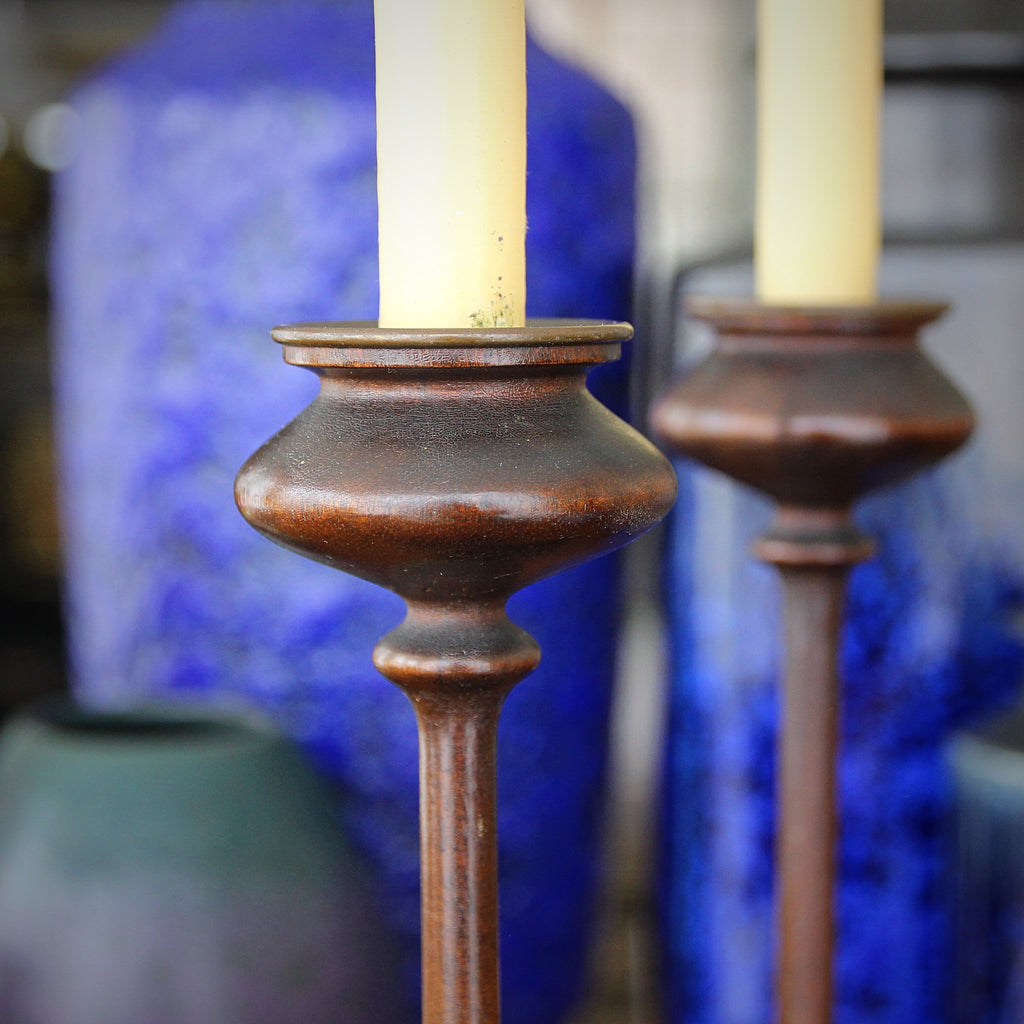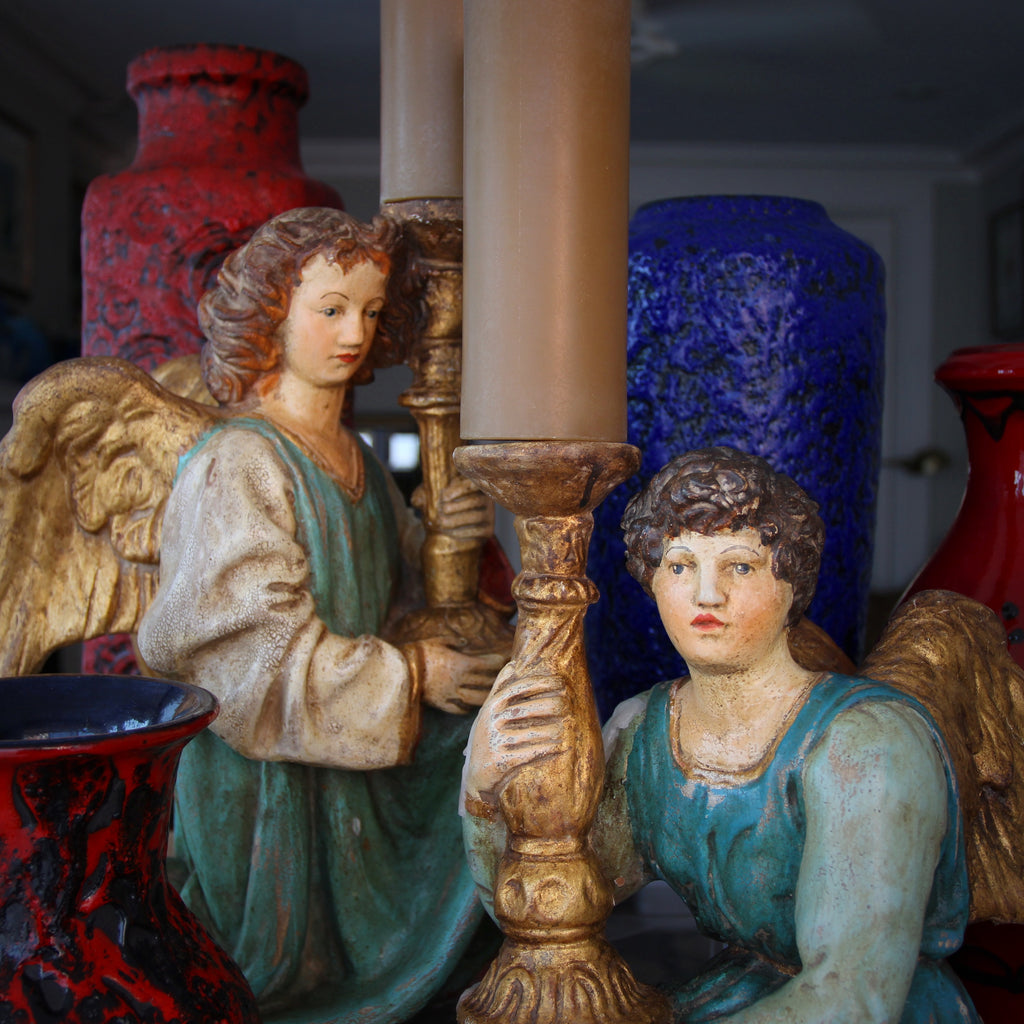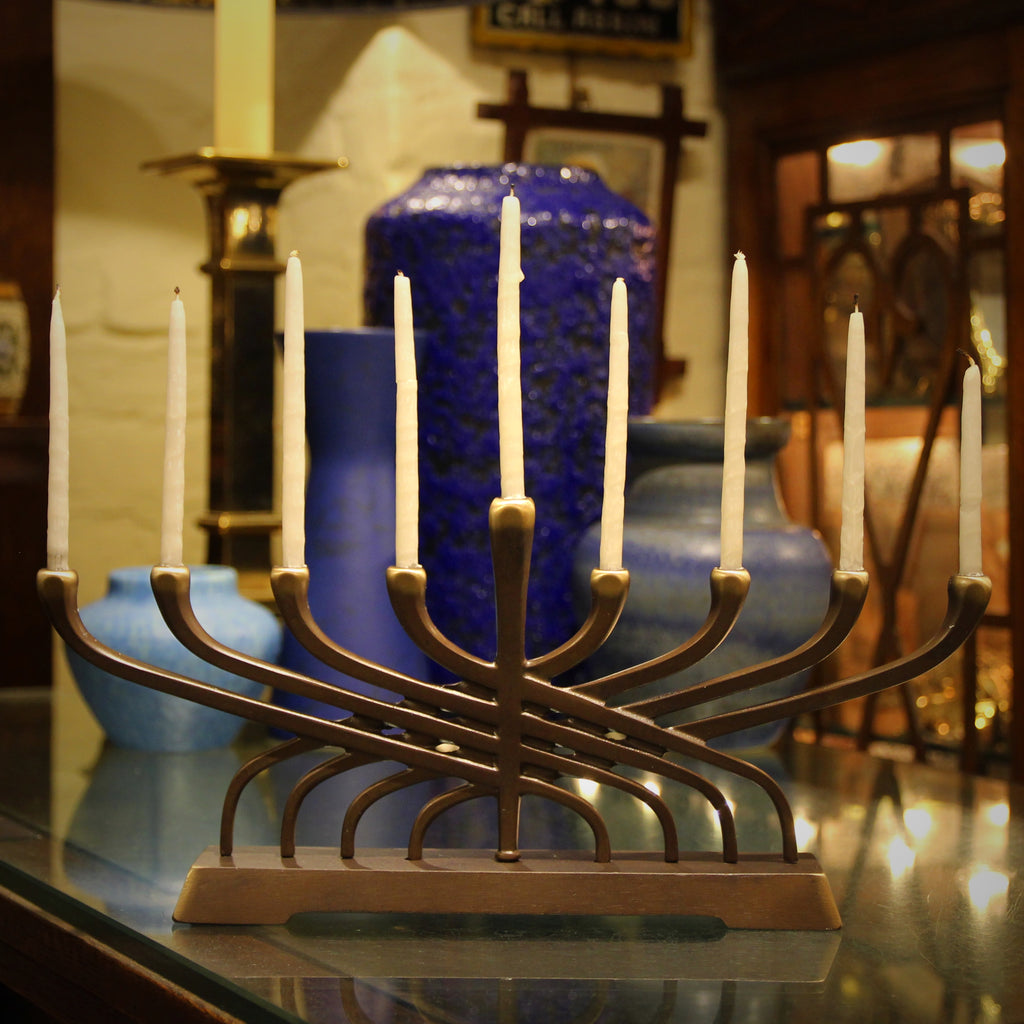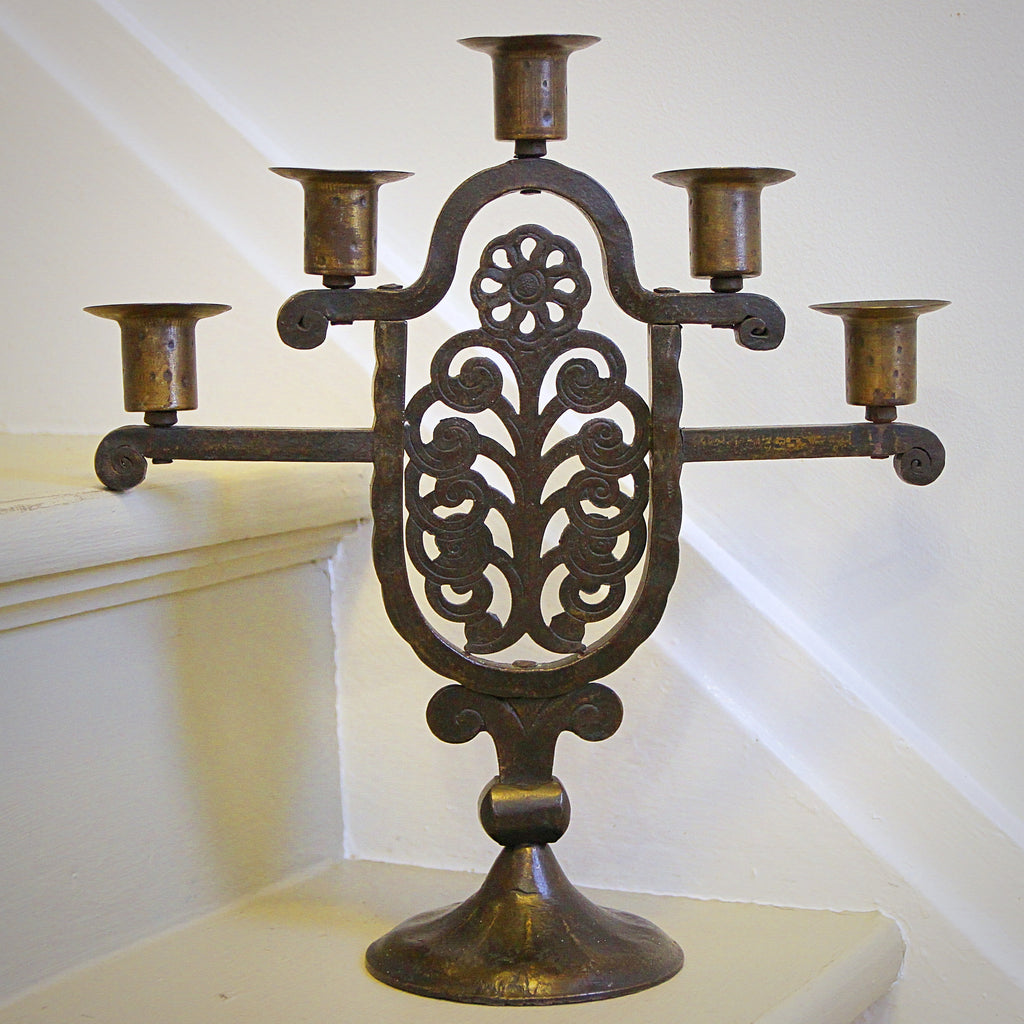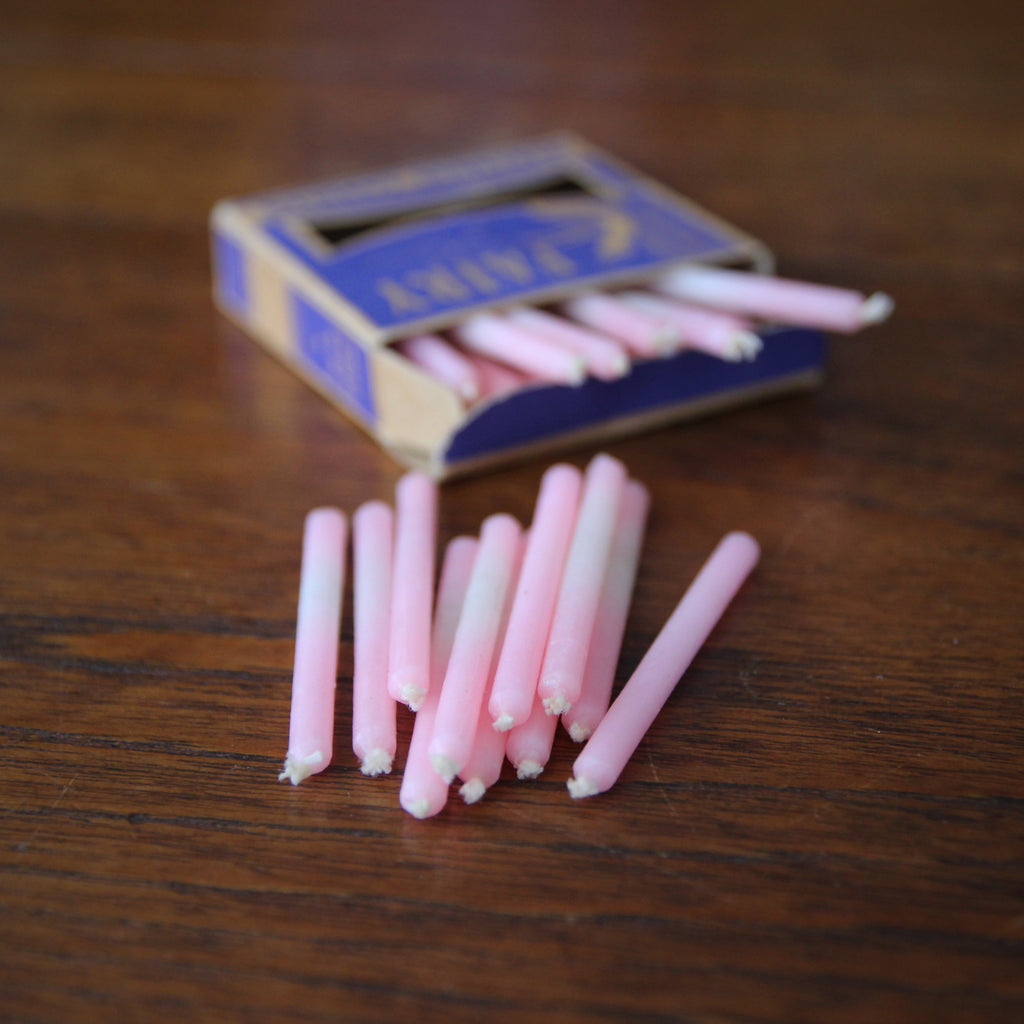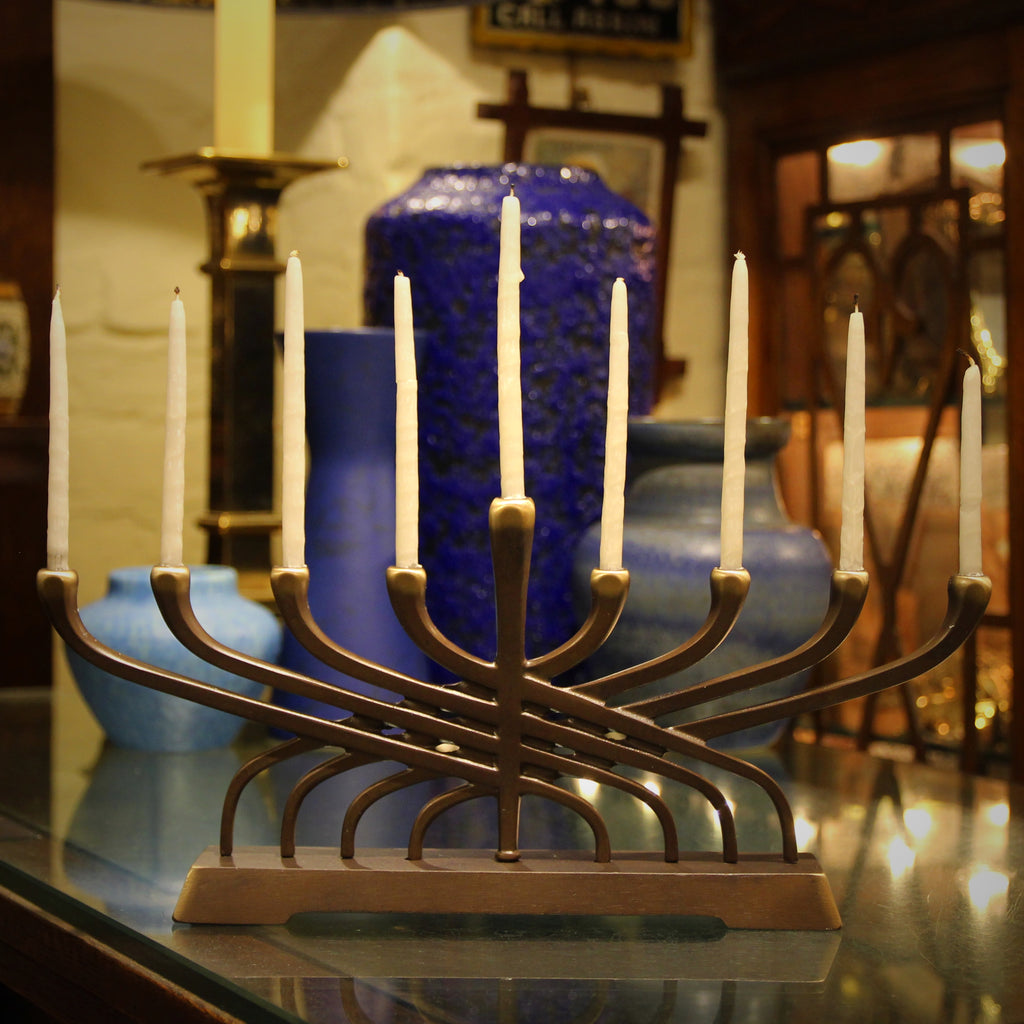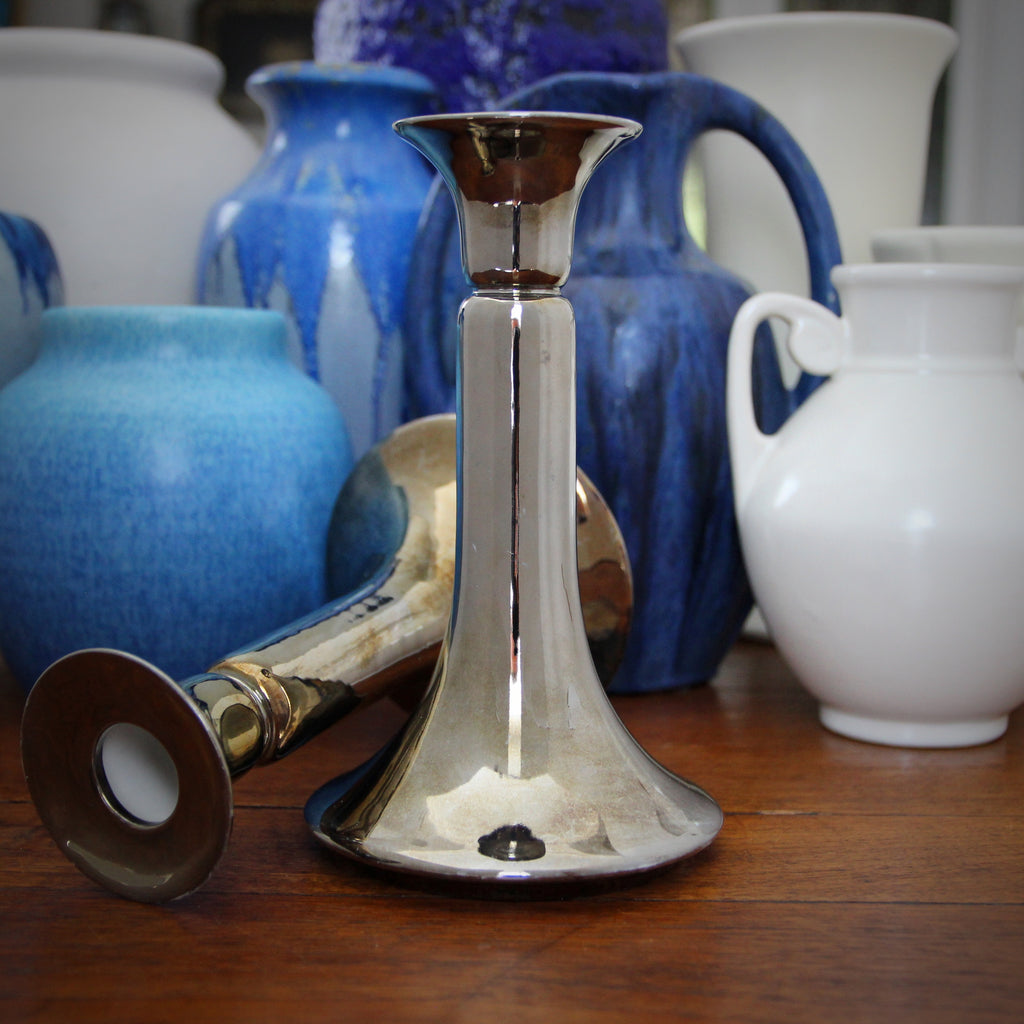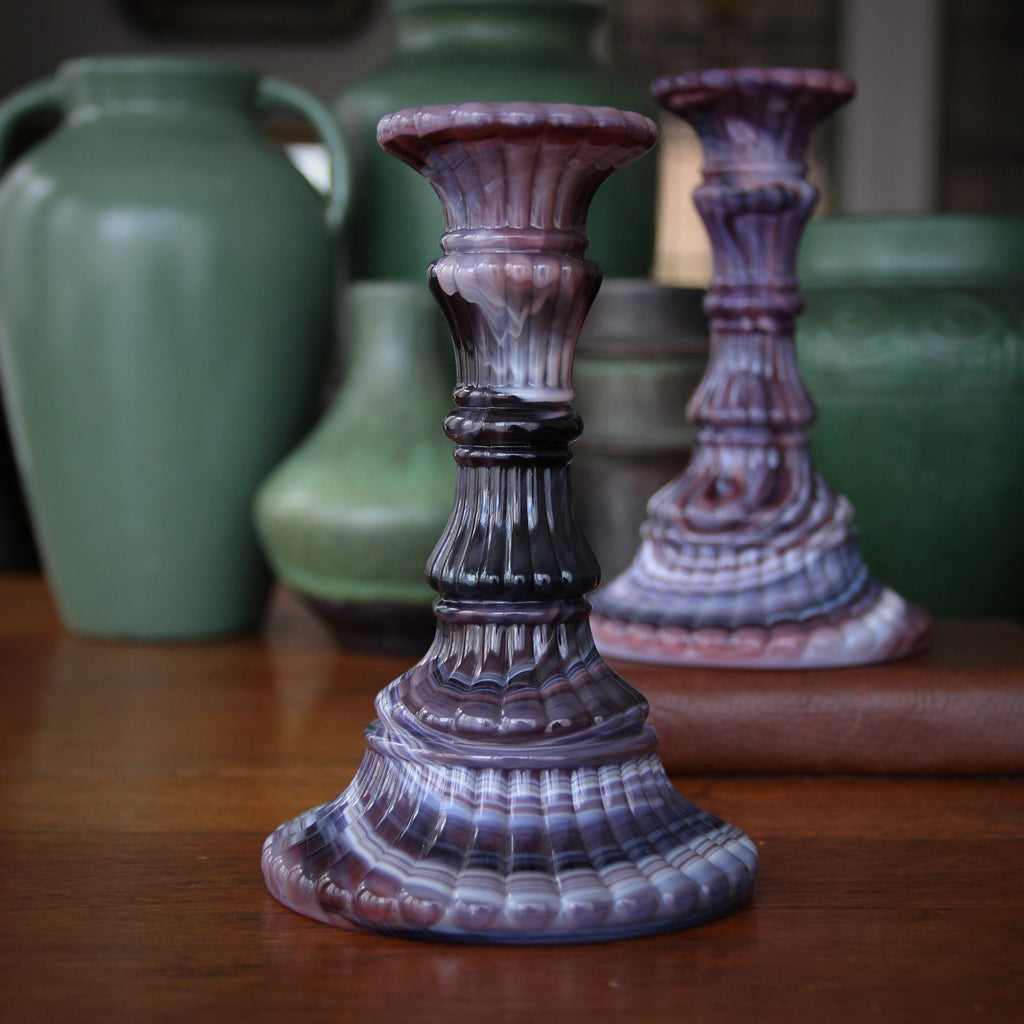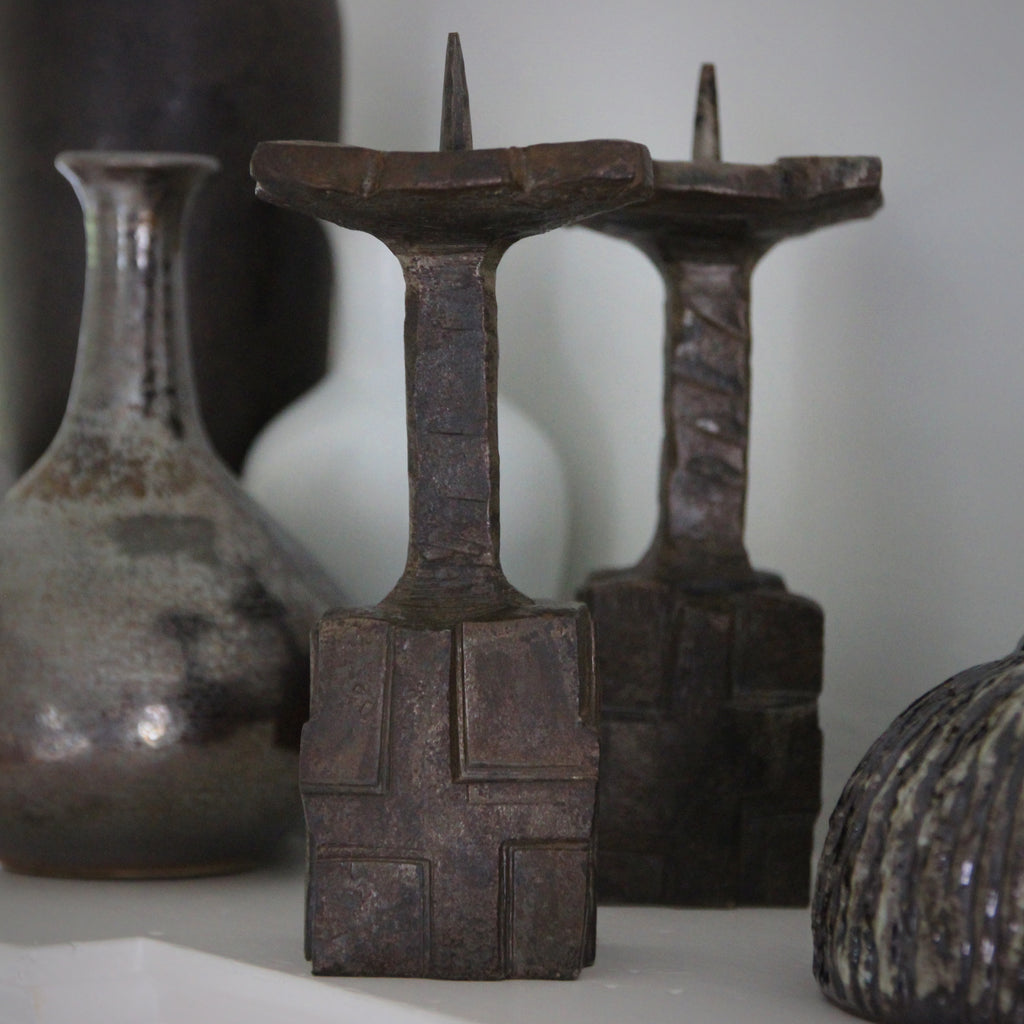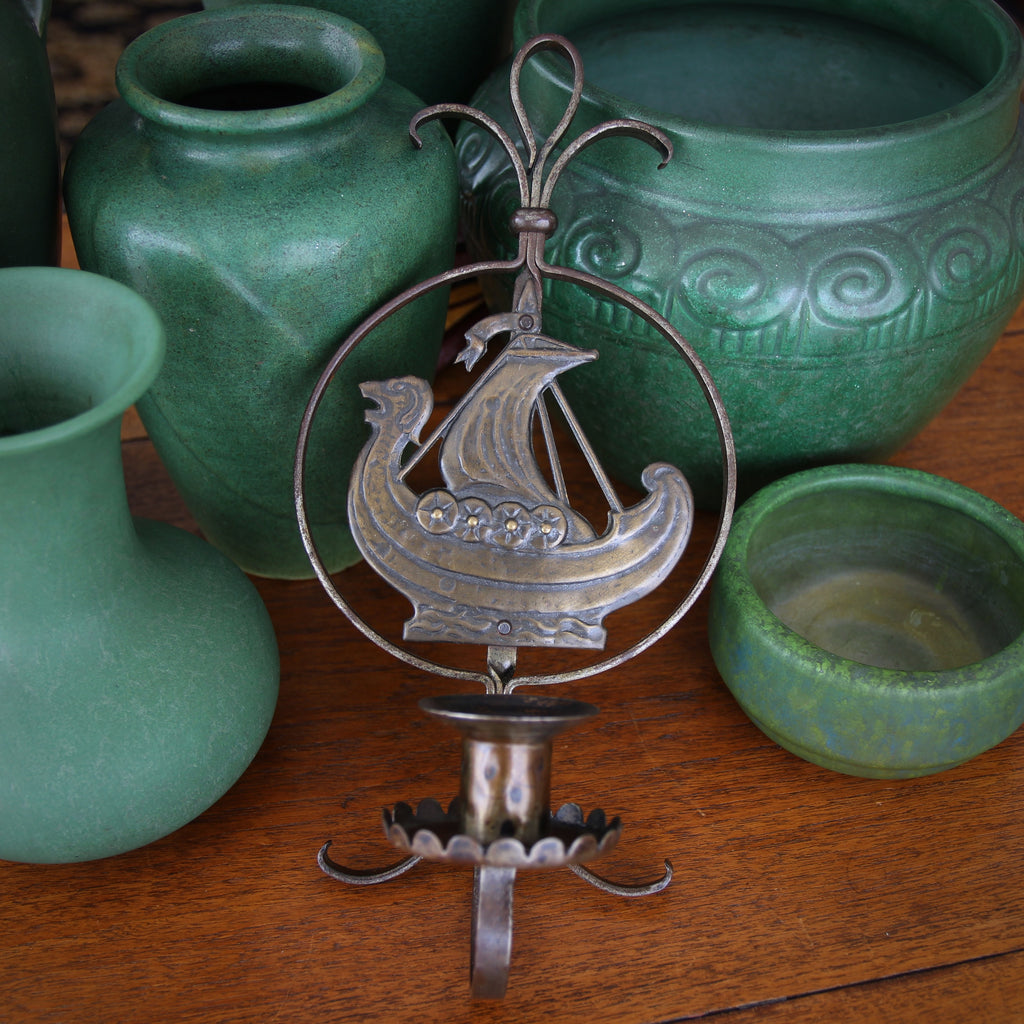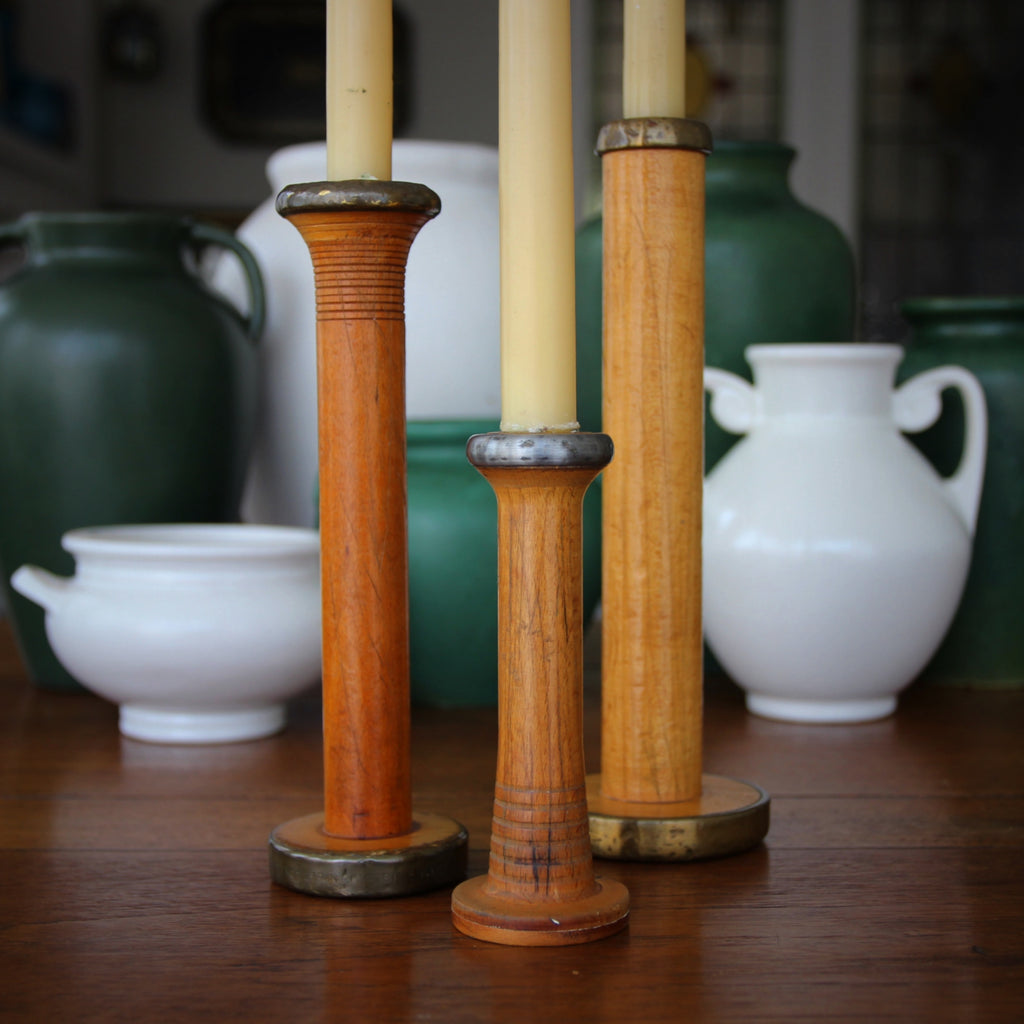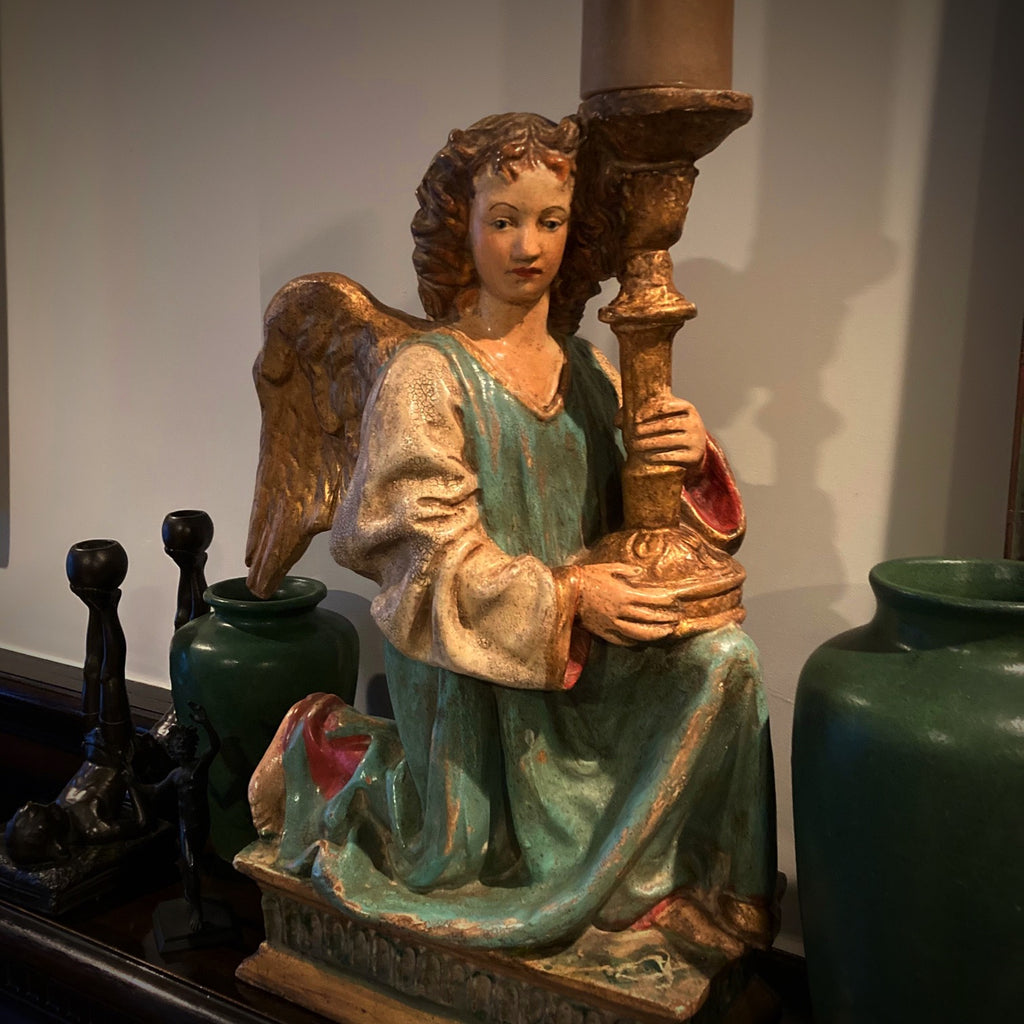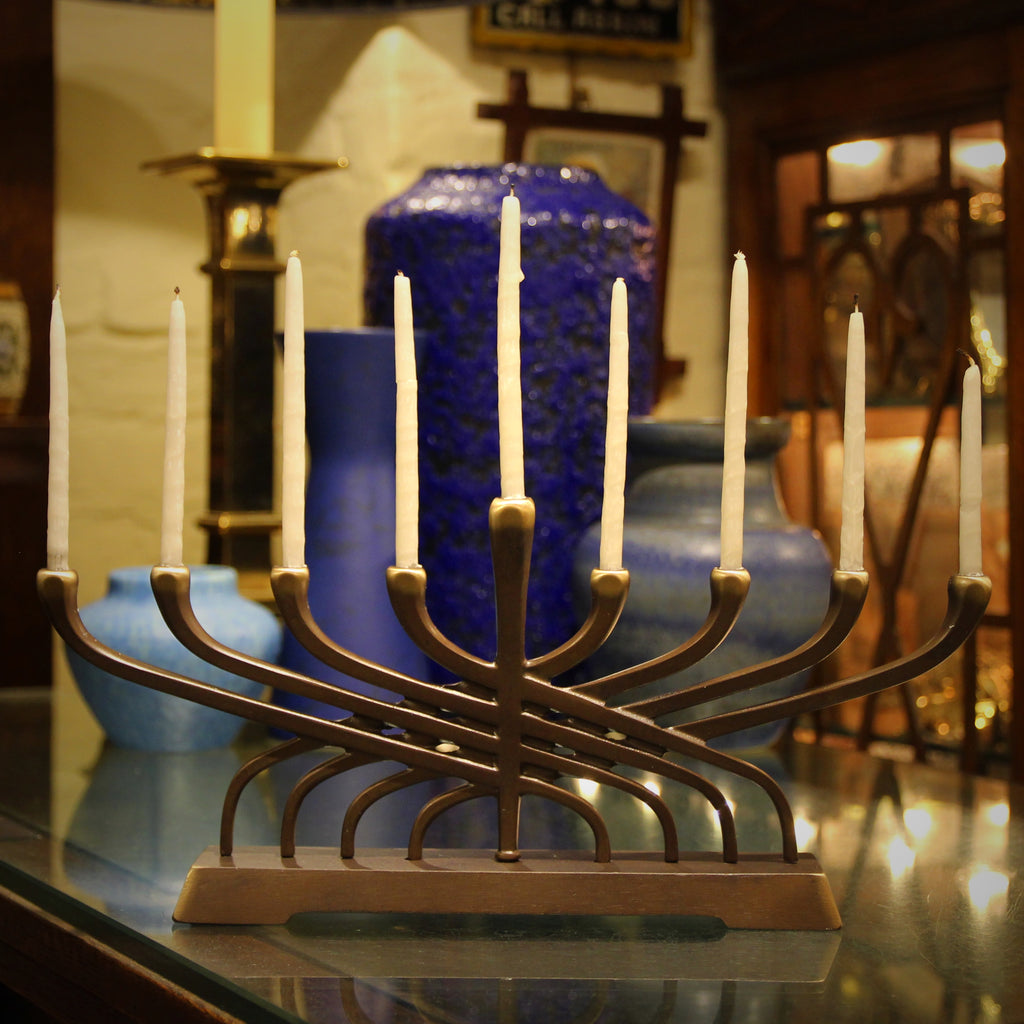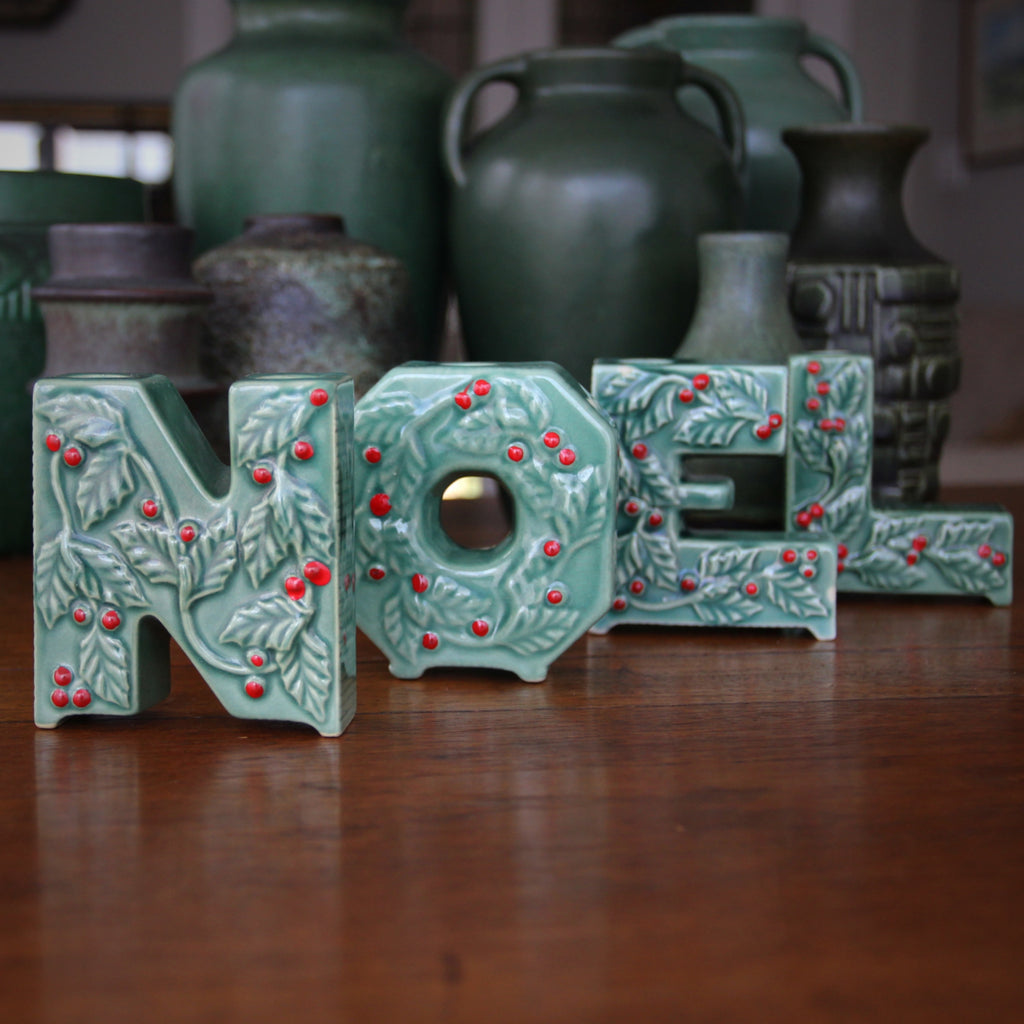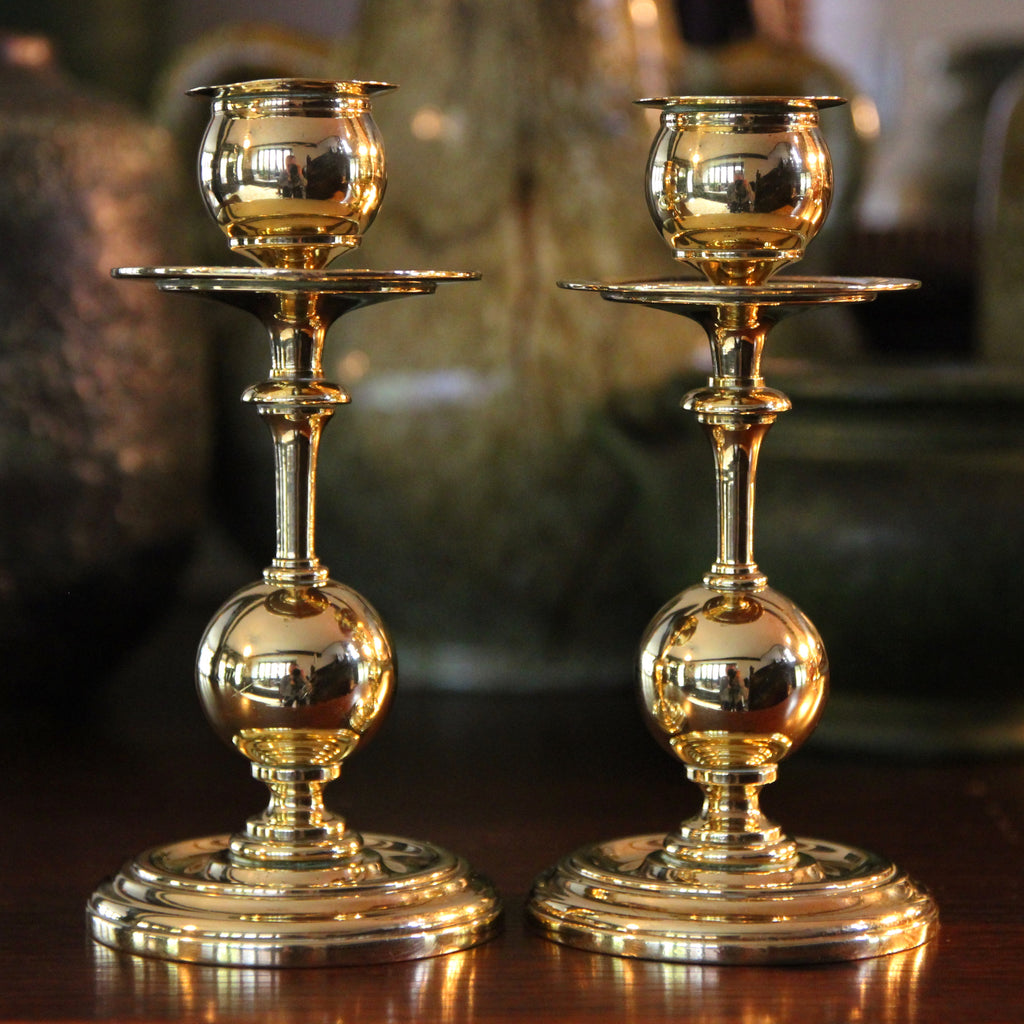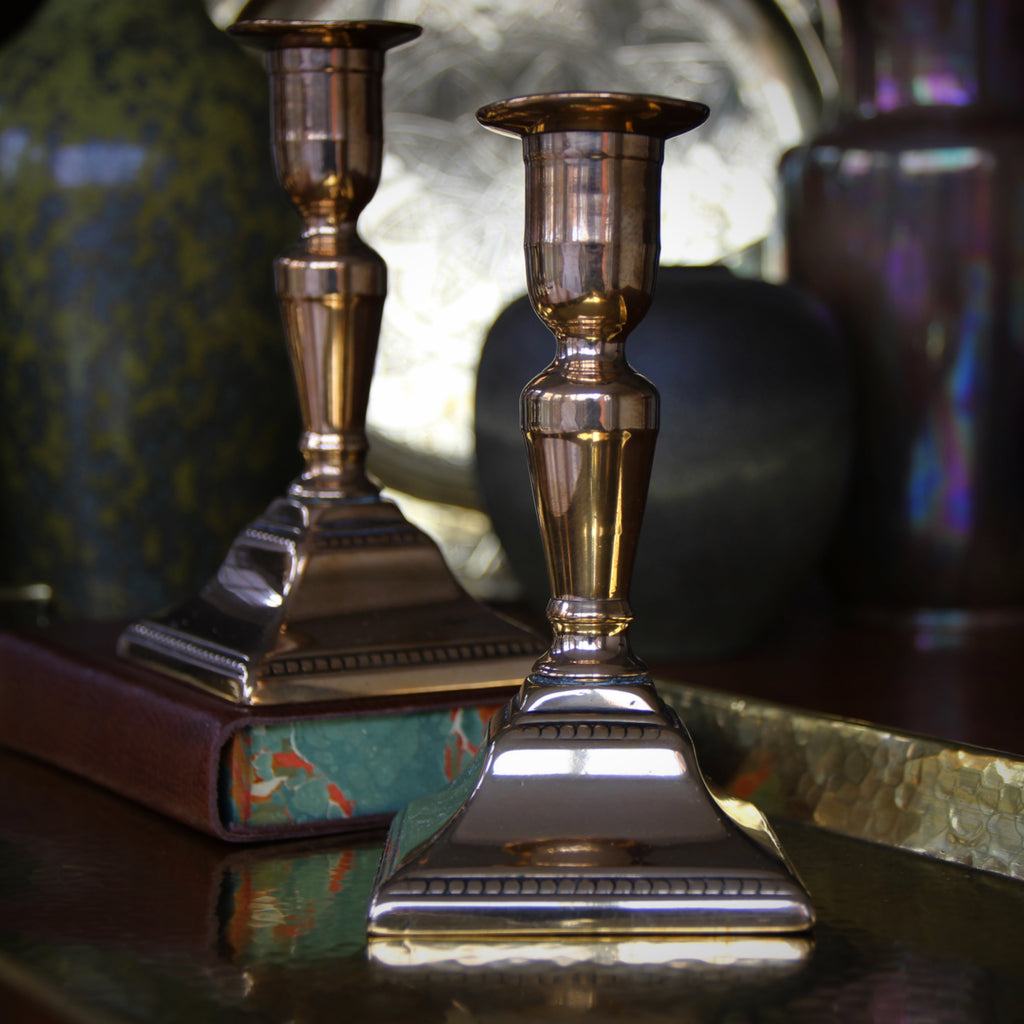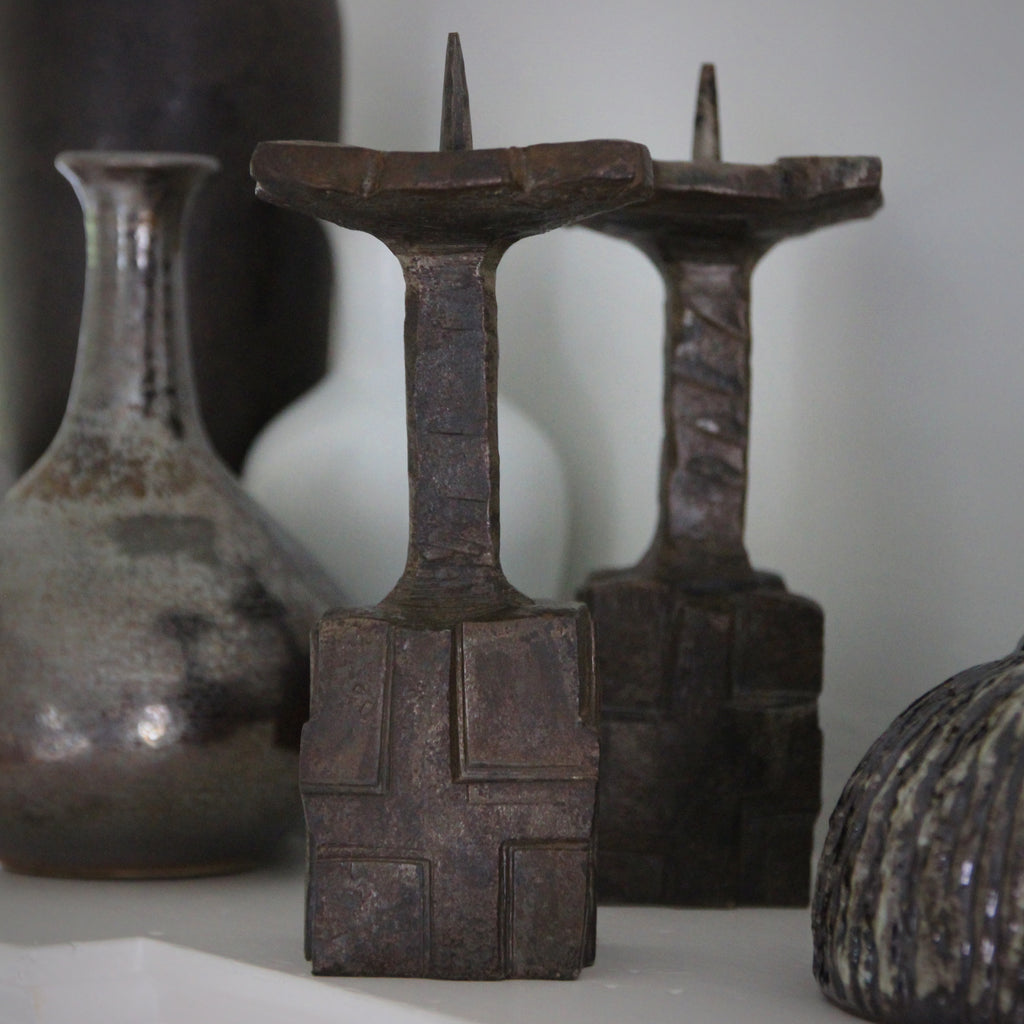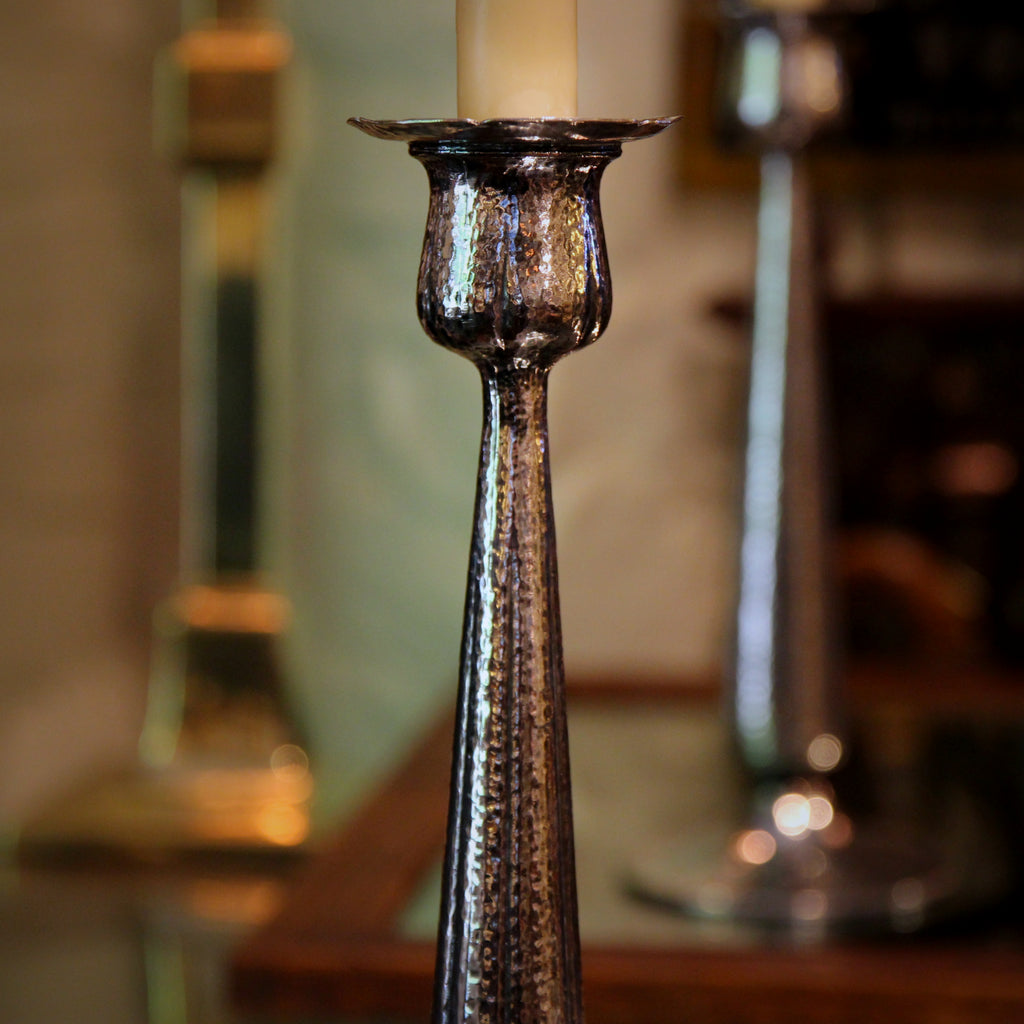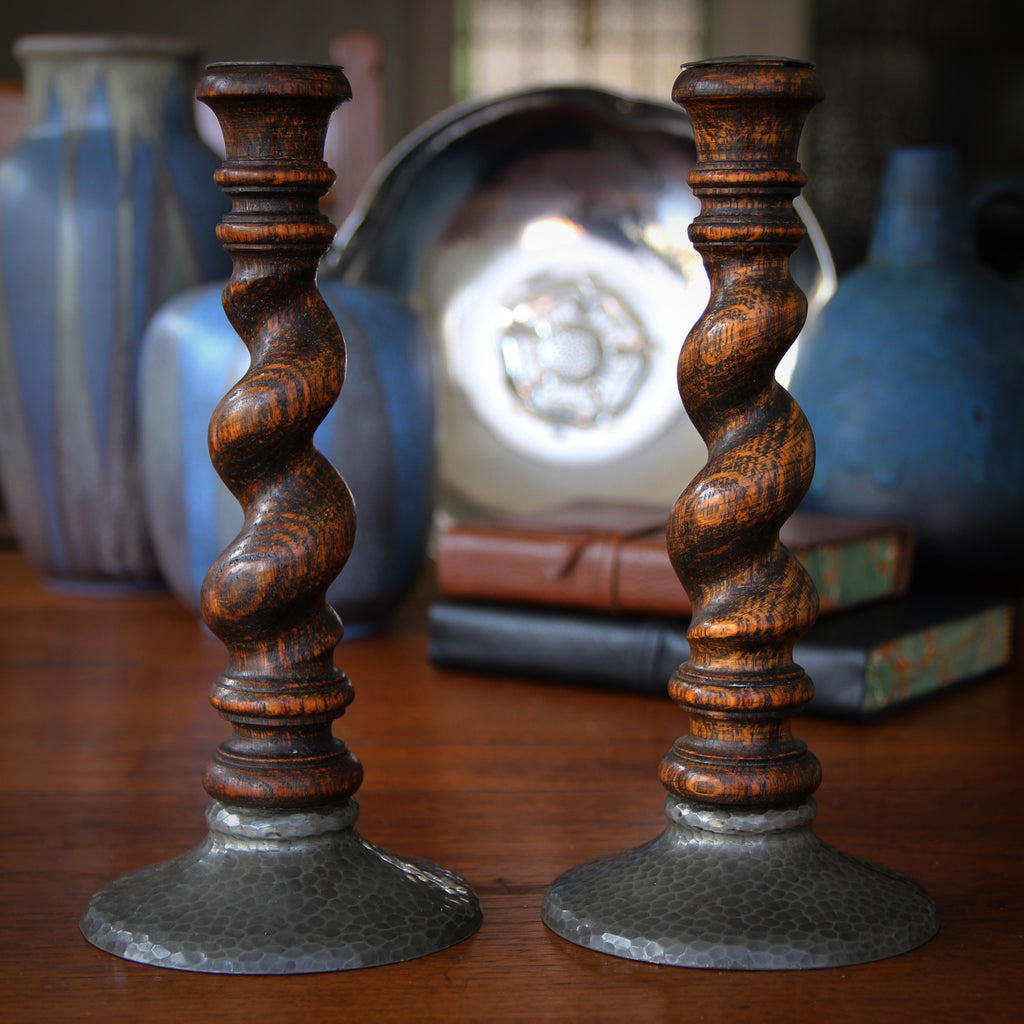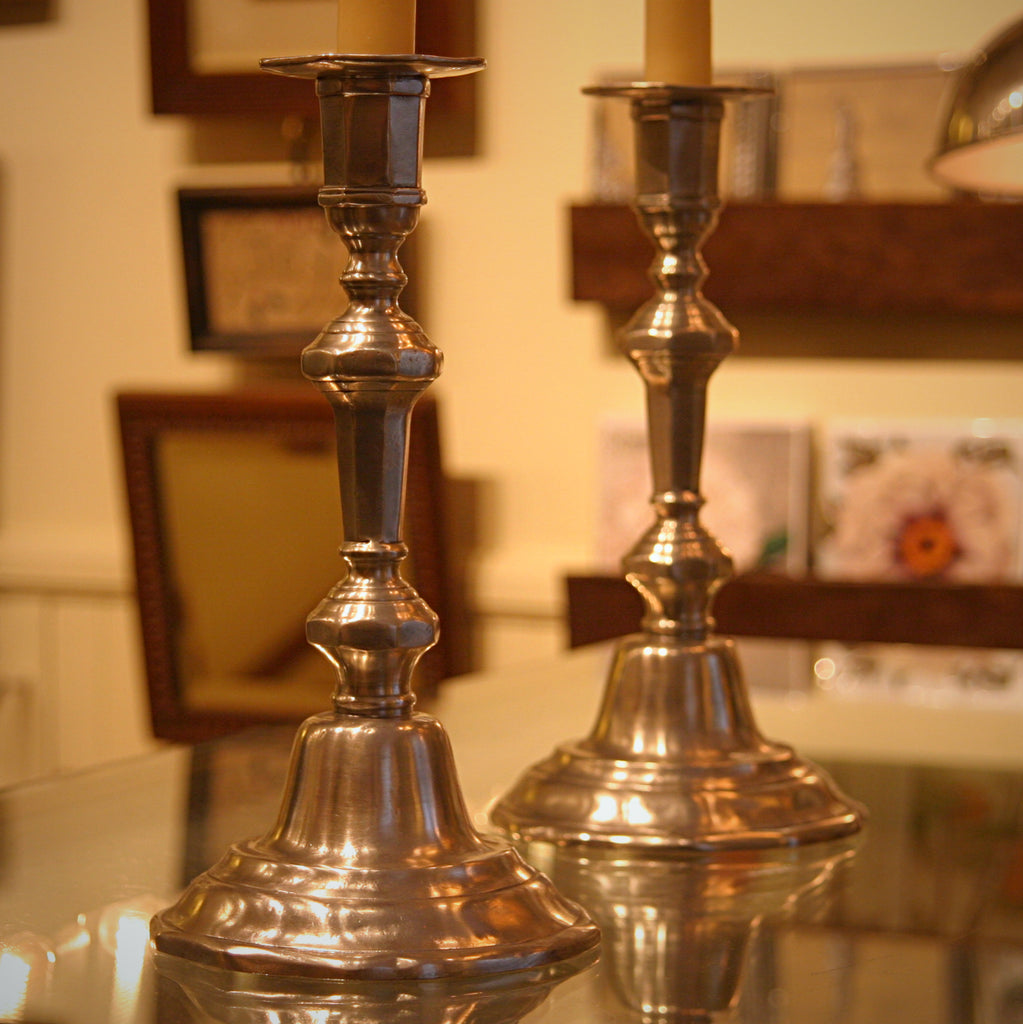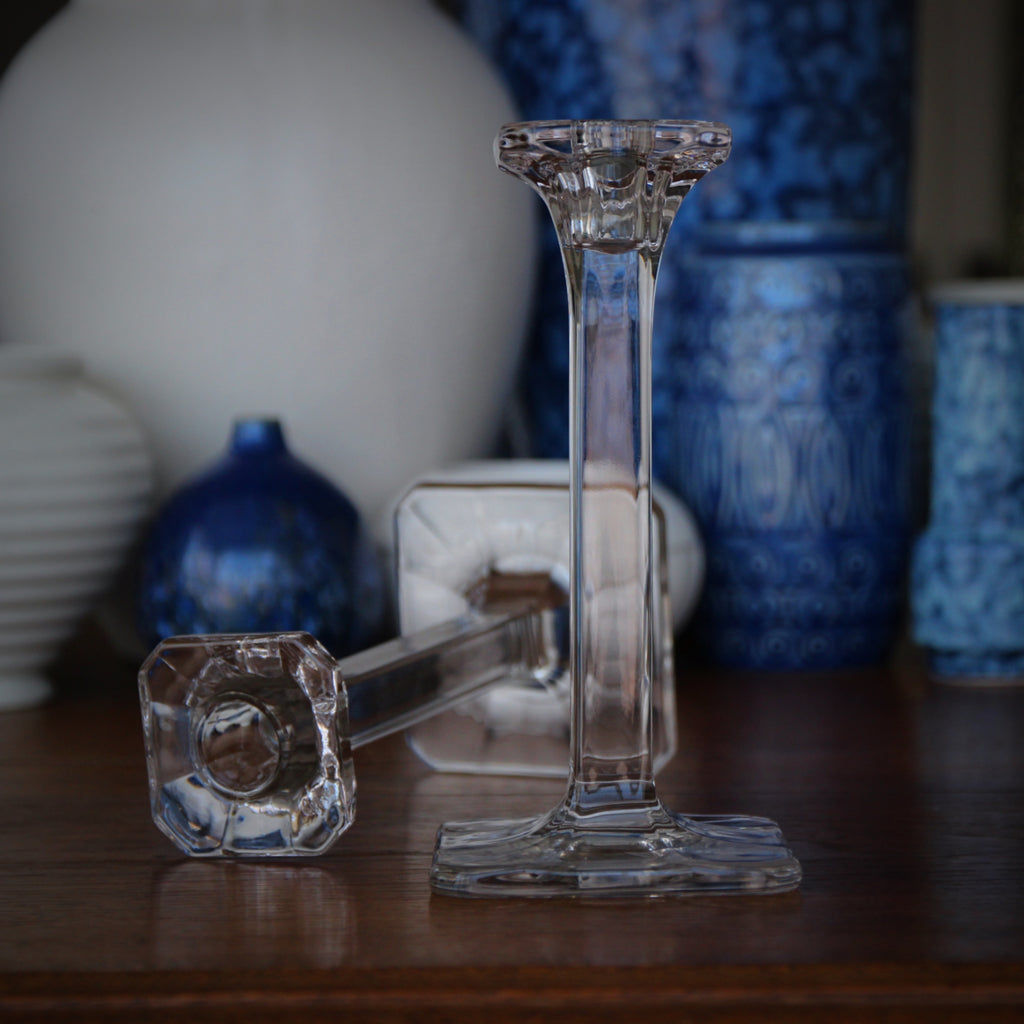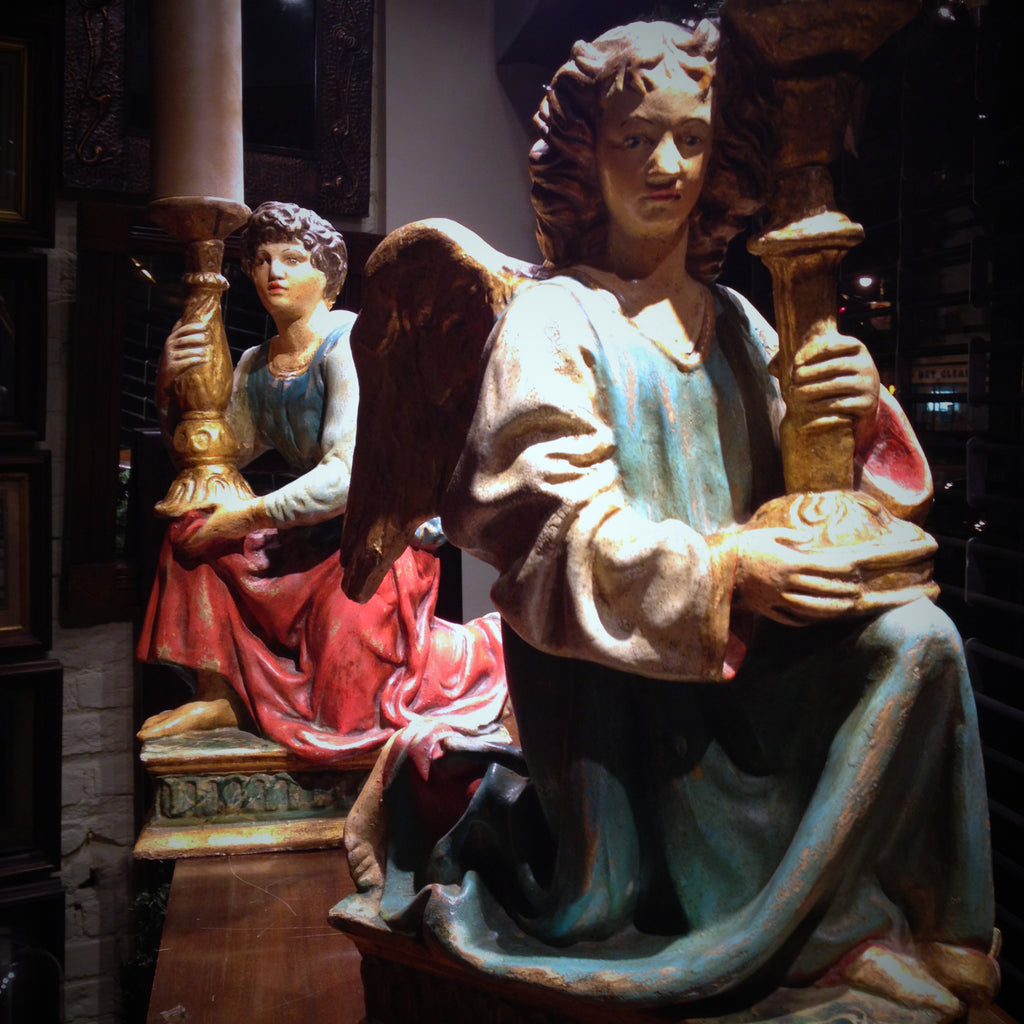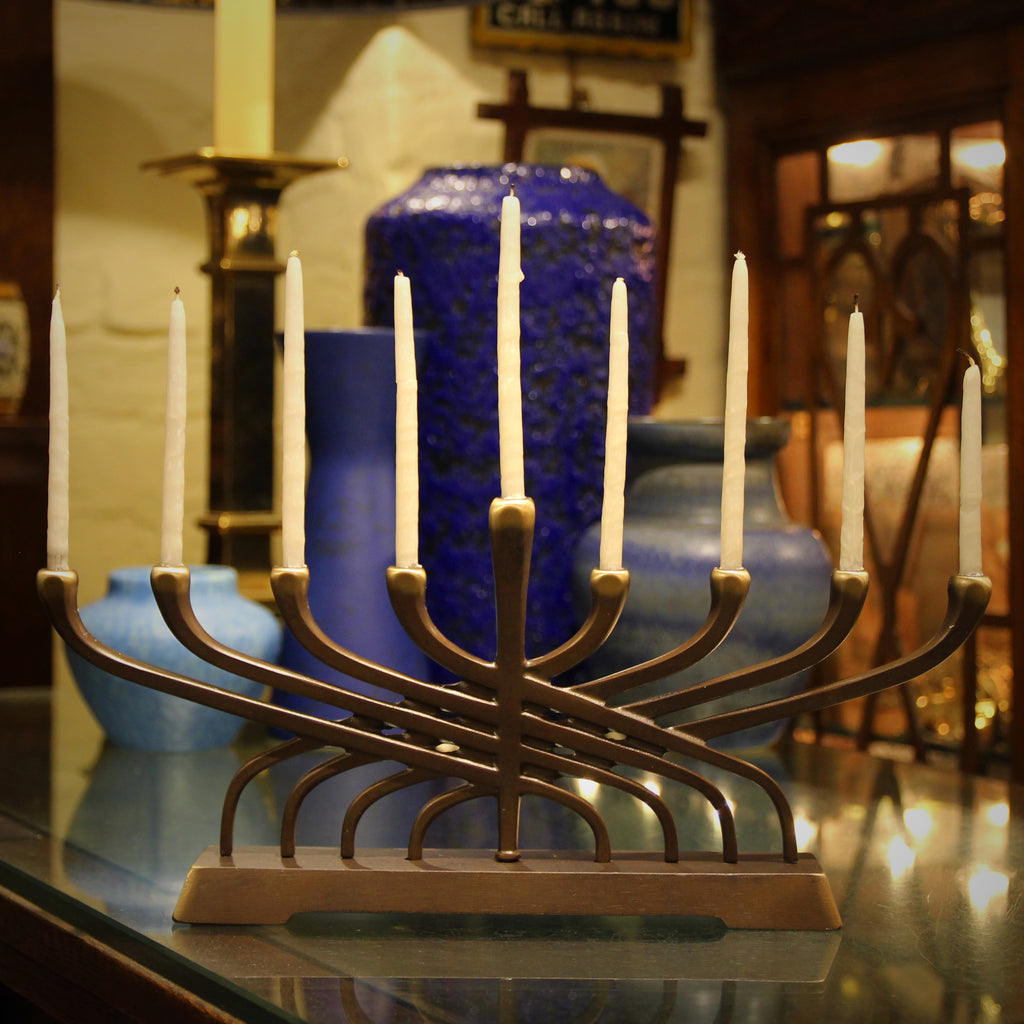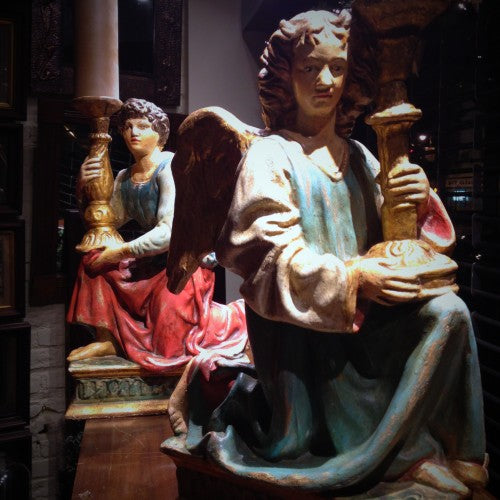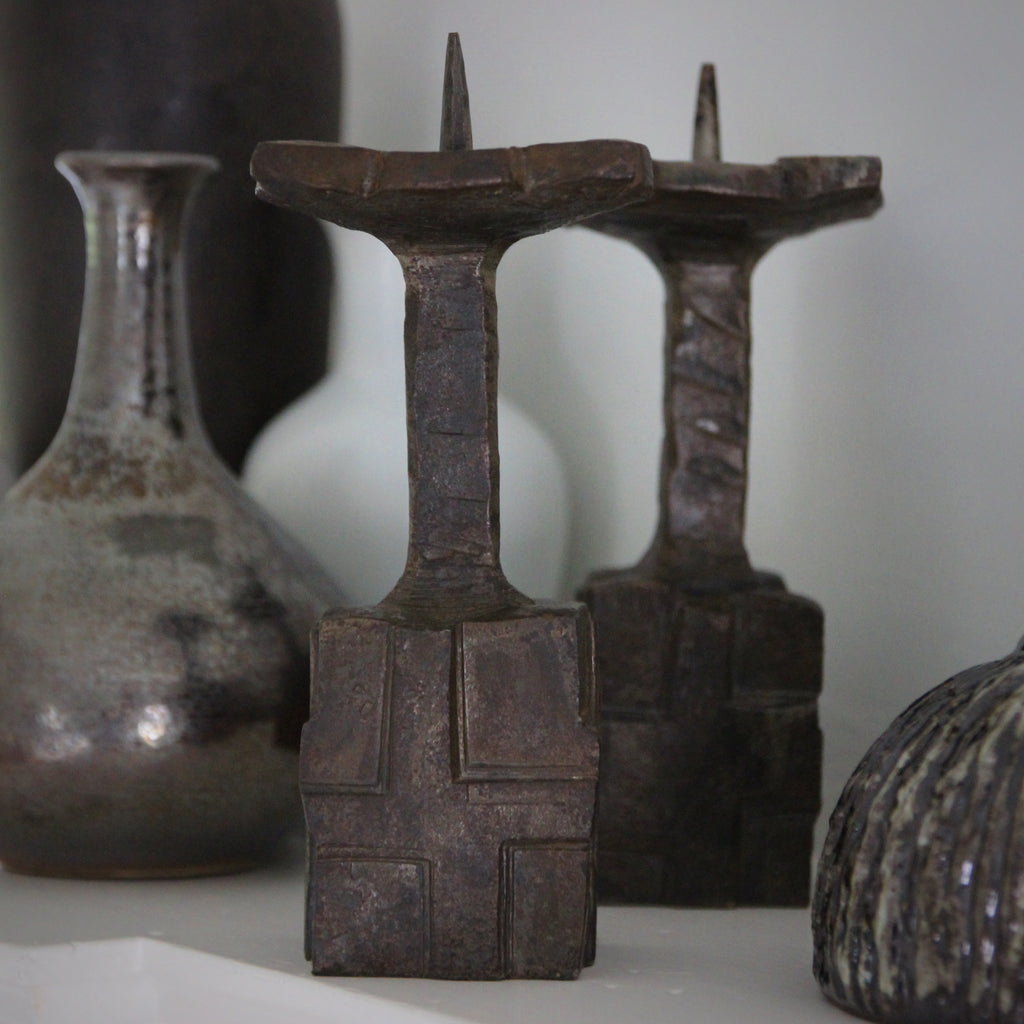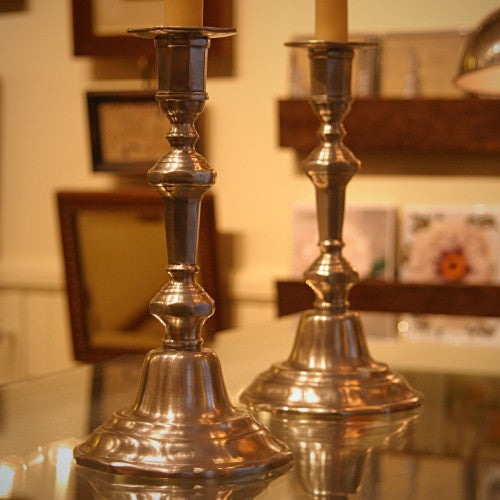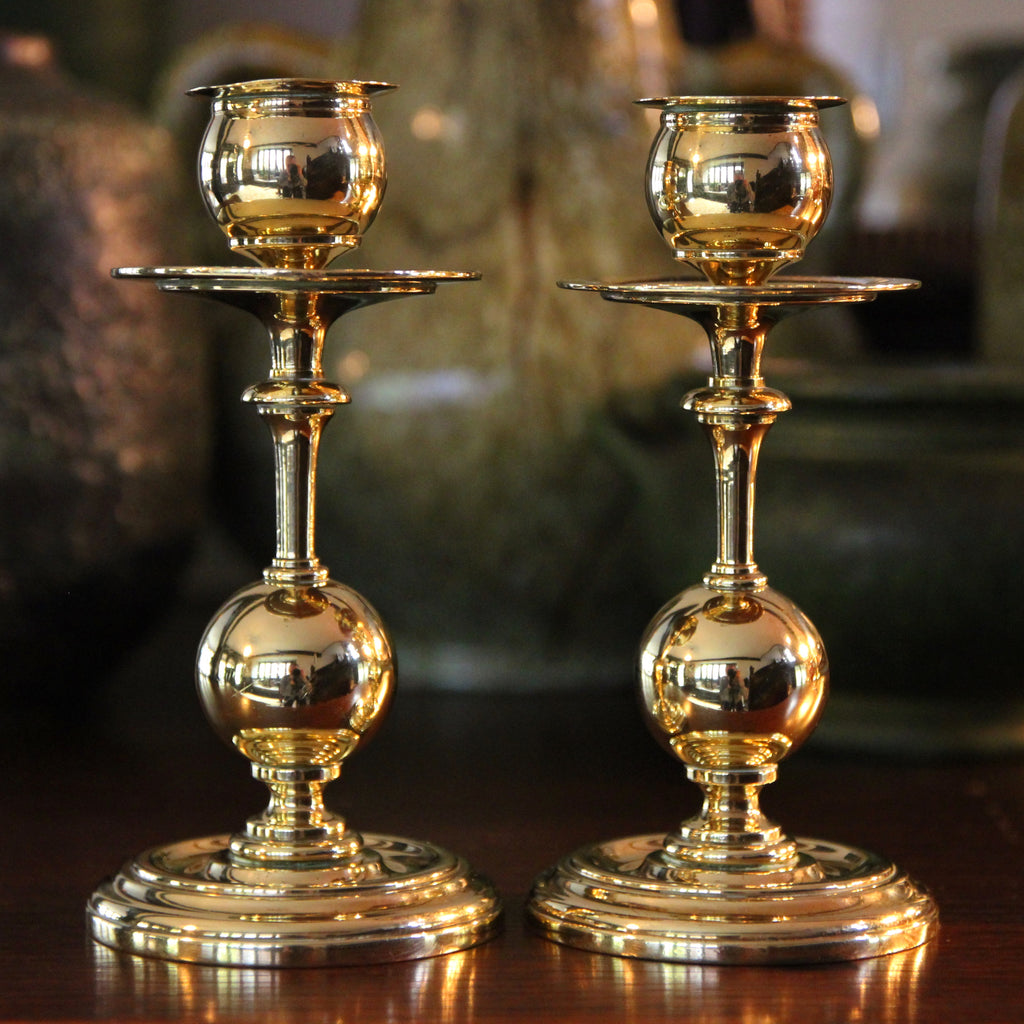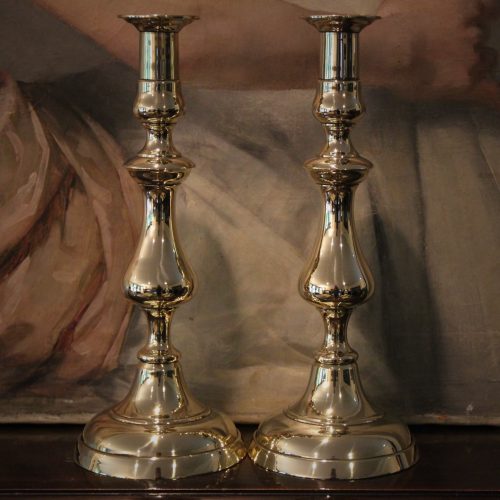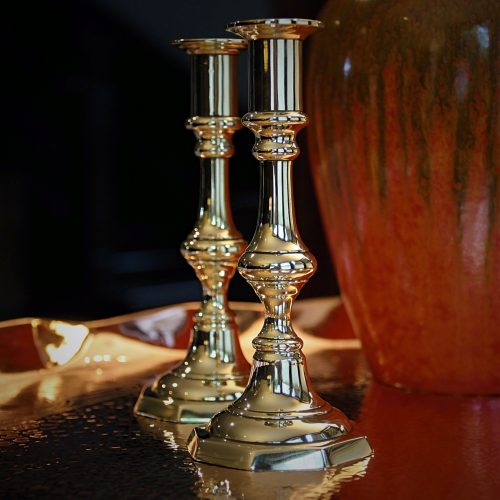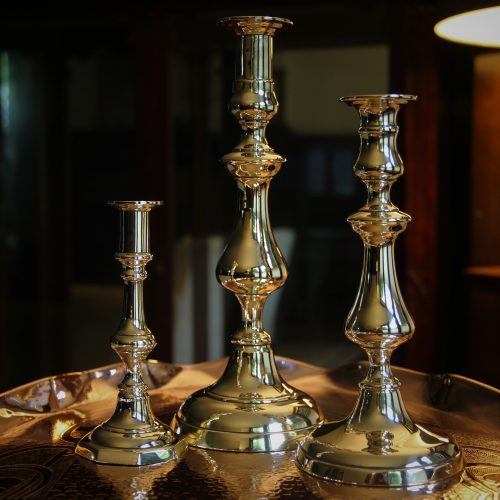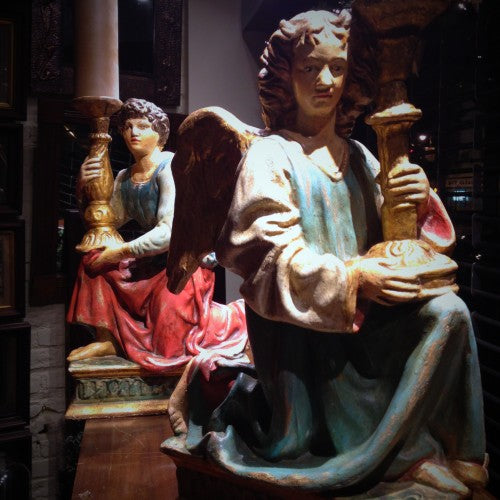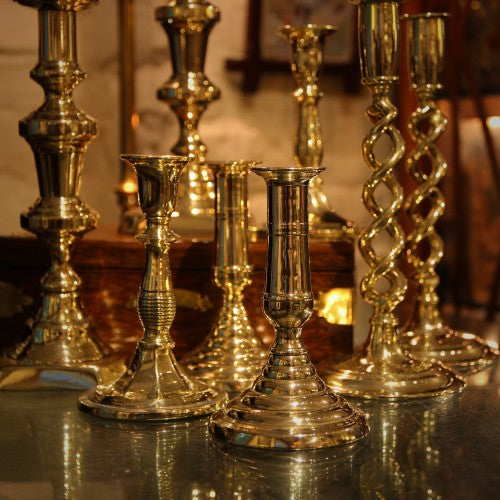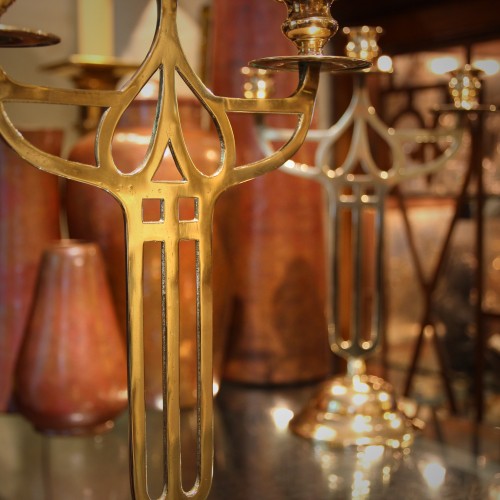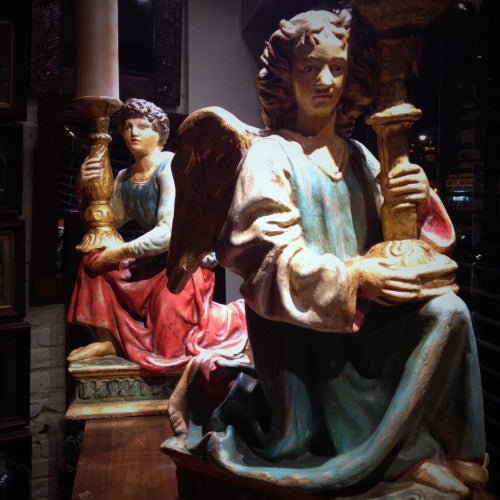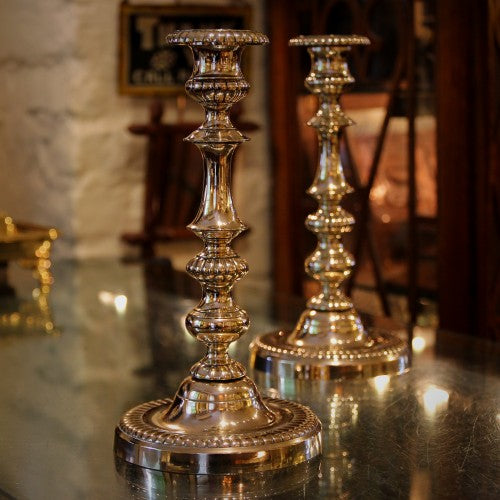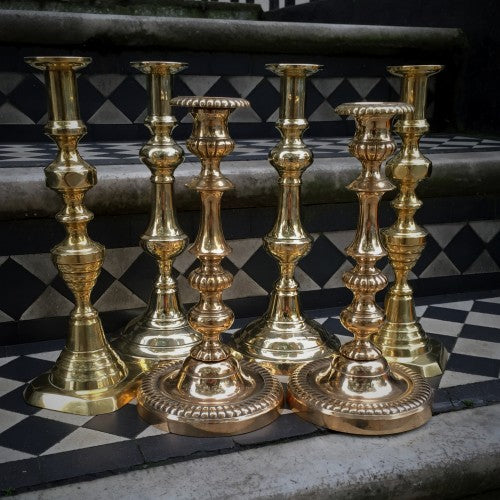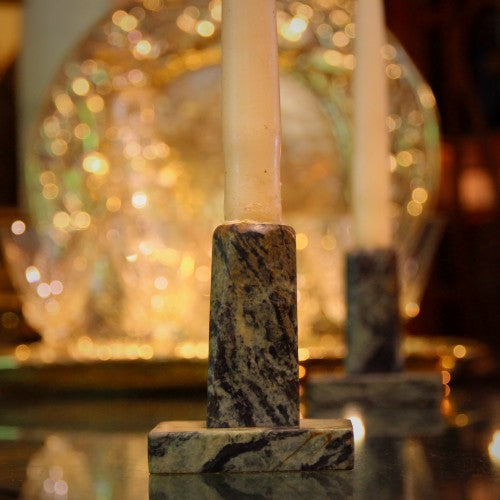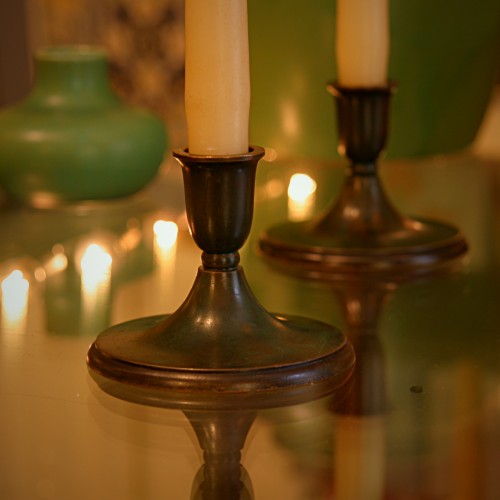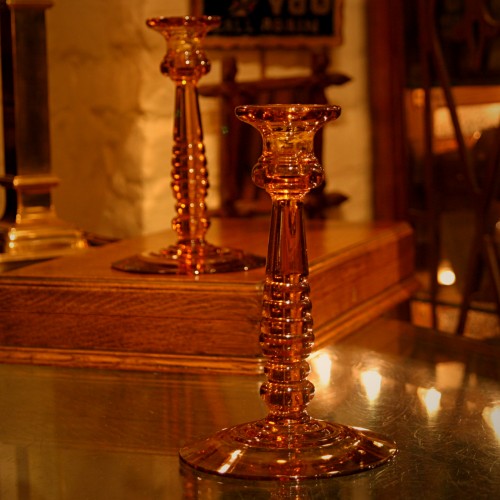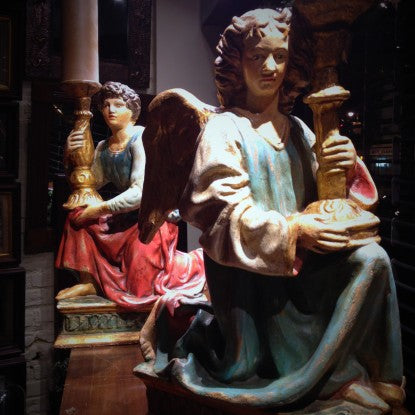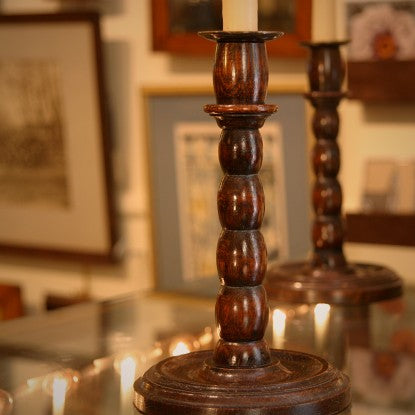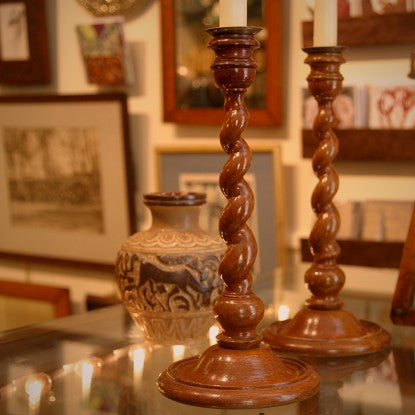JOURNAL — Candlesticks RSS
Christmas Eve was always a special night in the LEO Design shop in Greenwich Village. We always stayed open until 10:00 pm. Most of the day's Holiday Hustle already had died down by 7:00 pm.. And the customers who did come in—usually after dinner—were in a good mood and, often, feeling little pain. They were relaxed because they were staying in the city for Christmas. Nowhere to go but home! These customers might find a gift for someone they were seeing at New Years or, better yet, something nice for themselves. We used the quiet hours to fill-in merchandise, re-organize as needed, and change the window before Christmas Day. This always meant installing our pair of Italian polychromed terracotta angel...
Happy Hanukkah!
Hanukkah begins tonight at sundown. Wishing all a Happy Festival of Lights! Every great now and then, depending on the idiosyncratic inter-cyclings of the Hebrew (lunar) and Gregorian (solar) calendars, there may be two Hanukkahs in one calendar year. 2025 is such a rarity! Last year's Hanukkah ended on 2 January (2025) and this year's begins on 14 December (2025)—two Hanukkahs in 2025! Even more strange (and more rare) is a year in which where there will be no Hanukkah at all. 3031 (more than a thousand years away) will be such a year with no Festival of Lights (although there will be two Hanukkahs in 3032). This has never happened before—at least not in the 16 centuries since...
Good King Wenceslaus
On this day in 935, Wenceslaus I, Duke of Bohemia (sometimes called "Václav the Good") was murdered by his brother, Boleslaus I (called "Boleslaus the Cruel"). Wenceslaus was remembered as a good and charitable ruler and his martyrdom elevated his legend. His life exemplified the virtuous concept of "The Righteous King" (Rex Iustis)—a leader who demonstrated piety, charity and vigor. He quickly became a subject of local veneration and was declared a saint in very few years. The legend of his goodness spread, especially his generosity giving alms to the poor, orphans, widows, and prisoners. He was crowned "King" after death and (in 1853) became the subject of the English Christmas carol, "Good King Wenceslas."
Shanah Tova
Shanah Tovah and a Happy 5786!
Today is the first day of Rosh Hashanah—the Jewish New Year—which began at sunset last night. The modern holiday is celebrated for two nights, after which comes a period of reflection and repentance before Yom Kippur—the solemn Day of Atonement (the holiest day of the Jewish calendar).
The name Rosh Hashanah is translated as "head of the year," that is, the New Year. The celebration marks the beginning of the civil year and it is also the traditional anniversary of the creation of Adam and Eve.
Summer Skies
Is there anything more beautiful—more pristine—than a lovely summer sky? Whatever the shade of blue, whether with clouds or without, nothing is more perfect than a bright, heavenly-blue firmament. These sky blue candlesticks were made outside of Manchester, England, by Pilkington Royal Lancastrian. The company had a very inauspicious start. In 1889, the four Pilkington Brothers began to dig for coal along a new seam in Clifton, Greater Manchester. They found no coal; all they got was clay! At first, they attempted to make bricks, but the "marl" they uncovered was not ideal for that use. The secretary of the coal company happened to know William Burton, a chemist at Josiah Wedgwood, which was a successful, 130-year-old ceramics factory in...
The Barley Twist
In the evolution of aesthetic schools, rarely is there a sharp division between the old and the new—separating what had been and what is to come. Rather, existing fashions might be modified with changes which reflect the aesthetic movement which is waiting in the wings. Such intervals sometimes (and conveniently) are called "Transitional Periods." In the case of the Arts & Crafts Movement, period artisans and designers often sought inspiration from earlier, historic ideas. Such inspiration—whether artistic, cultural, literary or historic—was specific to the locale in question. The English may have lifted references to Medieval Knights. Germans may have revived ancient folklore. The French might tip-their-hat to Gothic motifs. In the pair of English candlesticks, shown above, the hand-hammered...
Handsome Candlesticks - Part IV
Let's end our little parade of candlesticks for Passover with this handsome pair of German Jugendstil hand-hammered iron candelabra. The German Arts & Crafts Movement was called "Jugendstil"—literally translated as "The Youth Style." Like other Art Nouveau movements, the Jugendstil emphasized human handcraft utilizing simple (natural) materials, sensuous forms, and motifs inspired by nature (botany and zoology). It was also an Avant-Garde departure (a Secession) from the prevailing trend of commercialized, industrial production. Hugo Berger was a metalsmith who opened a workshop in 1895 in Schmalkalden, a town in the state of Thuringia, Central Germany. His handwrought designs, inspired by Gothic metalworks, were mostly crafted in iron or steel--and sometimes enhanced with copper or brass embellishments. Not all of his...
Handsome Candlesticks - Part III
This week, we are observing Passover by sharing some of the handsome candlesticks, now in-stock at LEO Design.
These smallish Victorian English brass candlesticks are perfect for just the right spot. Standing under seven inches in height (and spanning less than three inches across the base), they might very well solve this problem: how to decorate a tight spot (and provide light) without sacrificing style or presence. They could be squeezed-into a crowded dining table or sideboard. Or they might fit nicely upon a windowsill or narrow mantelpiece. They were made in England in the 1860's - 1880's.
Handsome Candlesticks - Part II
To my mind, the Art Nouveau Movement is the umbrella "aesthetic school" under which the world's various Arts & Crafts movements abide. Throughout the world, wherever an Art Nouveau Movement existed, its artisans utilized naturalistic themes (from geography, botany or zoology) to influence their work. Handcraft was essential as was the employment of simple materials.
The Arts & Crafts hammered, silver-plated candlesticks, shown above, were inspired by tulips—the stems as well as the flower petals. They were made around 1910 by Meriden (founded in 1852 in Meriden, Connecticut.) The metal (copper?) candlesticks were cast and assembled, then hand-hammered, then plated in silver. They would bring a handsome touch of nature to your dining table, presiding elegantly over your festive entertaining.
Handsome Candlesticks - Part I
As we are in the eight days of the Jewish Passover, we are sharing some of our favorite candlesticks. Perhaps one of these—or one of the many others in-stock at LEO Design—might help you celebrate the holiday in style. A baluster is a single upright support often found holding-up a staircase rail or balcony railing. A balustrade is a line of such balusters—including the railing which tops them and the bottom rail (into which they are set). They can be made of wood, stone, metal or other man-made materials. Very often they are turned (or have a "turned appearance"), like the baluster candlesticks, shown above. These English candlesticks, made in the Thirties, are turned oak (yes, in the form of a...
Happy Passover
Tonight—at sundown—begins the Jewish observance of Passover. It will last through eight nights, ending at sunset on Sunday 20 April (which, this year, happens to be Easter Sunday). The first two nights of Passover usually receive the greatest attention with families preparing seder meals. Passover commemorates an event (as relayed in The Book of Exodus) which happened while the Israelites were enslaved in Egypt. God sent The Angel of Death to Egypt who was to kill all the first borns—human and animal. Believers were instructed to slaughter and eat a lamb and (importantly) mark their doorframes with its blood. As the angel performed his assignment, he would pass-over those homes which were thus marked, sparing those people. Passover candles customarily...
Christmas Eve
In my first year on Bleecker Street, I purchased a pair of polychromed terracotta candleholders from a workshop in Italy. I knew nothing about them—except that I loved the angels and I loved Italy. Despite their high price, I bit the bullet and purchased them. "Someone," I said to myself, "was sure to like them as much as I do." I have since learned that the male angel, shown above, was based on a sculpture carved by the teenaged Michelangelo for the Arca di San Domenico (The Tomb of Saint Domenic) in Bologna, Italy. He installed the angel candle-bearer in 1494 and was paid 30 ducats for his work. The boy-artist was also commissioned to carve small statues of Saints Procolo...
Now, for Something More Modern . . .
If your taste runs to the Modern, perhaps this cast bronze menorah will strike your fancy? It holds the requisite eight candles, one for each night, plus the shamash (or "helper candle"), which stands a little higher and is used to light the others.
With less than two weeks before Hanukkah starts (the first night coincides with Christmas Day), it's time to arrange your menorah in its place of honor for the holiday.
Two Weeks 'til Hanukkah!
It's two weeks until Hanukkah—the Jewish Festival of Lights.
The dates for Hanukkah follow the Hebrew Calendar—beginning on the 25th day of Kislev—and the holiday can fall anywhere from late November to late December on the Gregorian (modern day) Calendar. This year, Hanukkah will begin at sundown on Christmas Day. This coincidence occurs infrequently, most recently in 2005. Before that, Hanukkah coincided with Christmas Day in 1959, 1921, and 1910. The next time that Hanukkah will begin on Christmas Day will be in 2035.
The Hanukkah menorah, shown above, was cast in bronze in the form of a windswept cypress tree.
Hammered Elegance
Like the candlesticks we shared earlier this week, this elegant pair of American Arts & Crafts candlesticks have a botanical inspiration. The "cups" resemble tulip buds, just ready to open. The shafts reflect tapered, tightly-bundled tulip stems. And the "bobeches" are cut into a scalloped, petal-form shape. The entire candlestick is hand-hammered and silver-plated. They were made in Meriden, Connecticut around 1910.
My Favorite Things
One of my favorite finds of the last few months: a pair of English Arts & Crafts turned mahogany candlesticks. The "cup" at the top has a tulip blossom or poppy pod floral-form. And "knuckles" at the top and bottom of the reed-thin shaft give visual weight to the turning. Truly elegant! And much more impressive in-person.
Arts & Crafts Elegance
At first glance—which was from a distance—I thought that these English Arts & Crafts candlesticks were made of cast and patinated bronze. It was only upon closer inspection that I realized that they are mahogany, burnished with a warm, reddish finish. These elegant floriform sticks bear a stylized resemblance to poppies or tulips. The cups are sensuously turned buds. The base is turned, too, with a pleasingly curvaceous profile. Finally, the two "knuckles" floating on each stem provide just the right punctuation to complete perfectly the design. The brass bobeches atop each candlestick—which prevents the candle flame or heat from harming the wood—are darkened with age. They nearly disappear into the wooden candle top.
Christmas Eve
In one of LEO Design's earliest years—on Bleecker Street—I acquired this pair of Italian polychromed terracotta angels, candle-bearers. Perhaps it was 1996 or 1997. I knew nothing of them, except that I liked them. They weren't old but they were Italian and they were sensational. On that first year, I placed them into the shop window on Christmas Eve. Over the next week, while they were still guarding the window, I got the occasional price enquiry but no serious interest. The next year (and the year after that) the angels made their way into the shop window on Christmas Eve. By now, the placement had become a bit of a ritual: at about 9:30 pm, half and hour before closing...
'Tis the Season - VI
Happy Hanukkah! The Festival of Lights begins tonight at sundown, lasting for eight consecutive nights. Each night, another candle from the menorah is lighted—using the Shamas ("the helper") candle at the center of the fixture. This Modernist Hanukkah Menorah is made of cast bronze. "Hanukkah Sameach!"
Durable and Good-Looking, Too
Metallic candlestick and ceramic candlesticks are both popular and commonplace. This pair combines both of those looks: a pair of porcelain candlesticks, glazed in a lustrous, metallic platinum gunmetal. The design also straddle the Classic and the Modernist. They were made in the Twenties by Fraunfelter in Zanesville, Ohio. Charles Fraunfelter was born in Akron, Ohio, in 1866. His wife's uncle was the president of Roseville Pottery and Charles worked his way up in that company: clerk, secretary, sales manager. In 1915, he (and a group of other business partners) purchased the Ohio Pottery Company and hired Austrian ceramicist, John Herald, to guide design and production. At this point, the company was mostly making stoneware kitchenware items like mixing bowls and...
Spring Tulips
Spring is here—and so are the tulips! I've always loved the "rubbery squeak" of tulip stems being arranged in a vase (always best with a fairly narrow neck). And a tulip's lovely cup-form blossom is unlike any other flower in the garden. The American Arts & Crafts candlesticks, shown above, were made by Meriden in Connecticut around 1910. The candle cups and stems are inspired by tulips. And their hand-hammered texturing—which was subsequently silver-plated—gives a soft sheen to the metallic surface. Meriden, Connecticut—about 20 miles north of New Haven—enjoyed tremendous prosperity during the Industrial Revolution in the second half of the Nineteenth Century. As the Nineteenth Century became the Twentieth Century, metalworks became the predominant industry of the city, which...
Good Friday
Good Friday is the most solemn day of the Christian calendar. It's the day when Christians contemplate and memorialize the condemning, torture, crucifixion and death of Jesus. Although the day is a dark one for Christians, it also marks the last hours before the great triumph, Christ's resurrection.
Shown above is a pair of German Jugendstil wrought iron candelabra. Made in the early Twentieth Century by Hugo Berger, they display the stark (but beautiful) aesthetic of honest handcraft. Wrought iron bars, some of them scalloped, support five candle cups. Pierced steel provides a stylized, floral inset. A softly faceted, hammered foot plate catches the light. And the dark patination gives the piece a centuries-old appearance.
Jugendstil
The Arts & Crafts movement in Germany was called Jugenstil, literally "the youth style." Like with Arts & Crafts movements elsewhere, this aesthetic school marked a break from the prevailing Nineteenth Century aesthetic—thus it was new and fresh (that is, youthful). The Jugendstil Movement promoted a revival of handcraft, simplicity of design, and the use of natural, honest materials. The movement was influenced by the Arts & Crafts movements of other countries and, in turn, it influenced other Modernist movements, especially in Northern Europe.
One "subset" of German Jugendstil (and Viennese Secessionism) exhibited a crisp, understated angularity, often in metalwork. These steel chambersticks, made in Württemberg, Germany, are a blend of primitive simplicity and industrial modernism.
A Merry Fairy
Pull-out all the stops at your favorite fairy's birthday party this year. A box of 35 candles, striped in pink and white, come in their original Fifties box—from which a winged fairy endows her blessings upon the occasion. You may be tempted to use them one-at-a-time; they're too cool to immolate in a blaze of fire.
Countdown to Christmas - VI
It is not only one week 'til Christmas. It is also the first night of Hanukkah! Hanukkah—the eight night "Festival of Lights"—celebrates the rededication of the Second Temple by God's People of Israel. The Books of Maccabees relates a story that only one night's worth of lamp oil could be found—and yet—the lamp burned for eight nights. Hanukkah menorah have eight candles, one for each night of the celebration, plus the "shammash" or "attendant" candle which is placed higher (or lower) than the other eight. This shammash candle is used to light the other eight candles—one each night. The Modernist bronze menorah, shown above, is ready for the Holiday Season. Click on the photo above to learn more about it....
Lustrous
In the world of ceramics, "lustreware" refers to the family of pottery in which a delicate, iridescent metallic glaze—usually a very thin treatment—lies upon the original (traditional) glazing. As with most pottery-making, the raw clay is formed and fired once, creating a plain "bisque" piece. The stoneware, ceramic or porcelain is now solid though not decorated. The piece is then glazed and a second firing "fixes" the glaze to the underlying ceramic. With lustreware, a light metallic glazing is applied over the first glaze—and the piece is fired a third time, but only lightly, enough to soften the first glaze and create the desired chemical reaction in the lustre glaze. Lustrous glazes use metal: usually gold, silver or copper. The...
It's February
Welcome, February, and your birthstone, the amethyst!
Amethysts were once amongst the most precious of "cardinal" gemstones—alongside diamonds, rubies, sapphires and emeralds. Their deep and regal purple coloration sat perfectly alongside the rich jewel tones of the other precious gems. In the Eighteenth Century, however, large deposits of amethysts were discovered in Brazil which reduced their rarity (and value), allowing wider distribution of the beautiful stone at more affordable prices.
More Light Forthcoming
Though the days now are getting longer and longer—ever sooo s-l-o-w-l-y—we crave more and more light. And we'd like it now! The shortest day of the year is a month behind us, but the longest day of the calendar is still five months away. Let these wrought iron Brutalist candlesticks help you illuminate your home. They were made in Germany after World War II and may have been avant-garde altarsticks from a Modernist church. The square bobeches will accept either a round pillar candle or a square columnar candle. Heavy bases provide stability while the rugged aesthetic adds a touch of primitive charm to an Arts & Crafts of Modernist interior.
Just Passing Through...
In Germany, the Art Nouveau movement was called Jugendstil—roughly translated, "The Young Style." Like its sister movements in other parts of the world, Jugendstil was a departure from the prevailing design-style of the day. It sought a return to simple materials and honest hand-workmanship. Additionally, there was an inclination to incorporate organic and naturalistic elements into the design—animals, plants, raw natural materials and spontaneous glazes. The various worldwide Art Nouveau movements frequently incorporated into their work the Ancient or Medieval design themes of their homelands. In England, designers revived Medieval chivalric tales and characters. In America, designers employed Native American decorative elements. And, in the case of the German wrought iron candle sconce, shown above, the designer features a brass seagoing vessel...
The Weavers
This trio of wooden spools would have been used by industrial weavers around the Turn-of-the-Twentieth-Century. The yarns would have been wound around the spools, each of which has been augmented with metal banding (presumably to protect a high-wear area). During weaving, as a particular color of yarn was used-up, an attentive weaver would have replaced the spent spool, keeping the machinery humming. The contrast between the warm, natural wood and the industrial form (with metallic banding) creates an interesting juxtaposition of material and form. They are shown being used as primitive candlesticks, however, because they do not have wide bases, they should be carefully supervised (or tacked-down with museum putty) to monitor tipping. Additionally, one should not burn the candle down...
A Christmas Eve Tradition
In 1995, shortly after I opened my first shop on Bleecker Street, I found an Italian importer from whom I purchased this pair of angel sculptures. They are cast and carved terra-cotta, finished with a colorful polychrome finish. I knew that they were not old—and that's all I knew. They spent the fall sitting atop the shop's fireplace mantel and, on Christmas Eve, I put them into the window. They were price-ticketed and available for purchase; alas, no one seemed to want them. For the next two years they made their annual Christmas Eve pilgrimage into the shop window, still for sale—but, to my surprise, they remained unsold. I had several price inquiries, but no one seemed willing to take...
Slag Glass
In old glass factories, where craftsmen were making objects out of colored glass, any broken pieces, scraps or bits of leftover glass would be tossed into a pile called the "slag heap." Every now and then, the artisans would scoop-up a shovelful of this random, mixed-color glass for use in making a one-of-a-kind art glass piece—perhaps a bowl, a lamp shade, or a sheet of flat glass to be used for a stained glass window. Such one-off pieces of glass were called "slag glass."
Hanukkah Sameach!
Happy Hanukkah!
May this Season of Lights remind us what's most important.
"Next year . . . together!"
Off to the Races!
Today is Black Friday, the so-called "Biggest Shopping Day of the Holiday Season" (more about this later). My first "professional" Black Friday was in 1985 as a 22 year old, brand new department manager at G. Fox Department Store in Hartford, Connecticut. The tables on my "pad" (retail speak for the carpeted area that defines the boundaries of a department) were piled-high with sweaters and poly-knit turtlenecks—all marked down from $28 to "the magic price point" of $19.99. It was a whirlwind season for this recent college graduate. I spent my time just getting through the day: helping old ladies find their sizes, filling-in new merchandise, keeping the cash registers humming, and marking-down new items as panicked buyers (in the...
Prolonging the Light - Part III
At nine and a half inches tall, these Victorian Brass Candlesticks will certainly make a statement in your home. Add a twelve inch taper and candle approaches 22 inches tall. And the heavy, "balustrade" form will add curvature and class to any dining table, mantelpiece or sideboard. Click on the photo above to learn more about them.
Prolonging the Light - Part II
Made around 1880, this pair of Victorian English brass candlesticks seem to offer a tip-of-the-hat to Dr. Christopher Dresser, the important designer and tastemaker of the British Aesthetic Movement. While not overly tall, they convey a nice visual weight—and would elegantly hoist a rather tall taper. Click on the photo above to learn more about them and, perhaps, bring them home for use on your table, window ledge or mantelpiece.
Prolonging the Light - Part I
Soon the daylight will seem short—and we will seek to create more light to live by. For centuries, candles filled that need and metalsmiths, by blending function and artistry, crafted candlesticks to hold those candles. This pair, made about 1820, are simple, elegant and understatedly handsome. They've been useful and elegant since the late Georgian period—and are still wonderful two hundred years on. Click on the photo above to learn more about them.
Good Friday
Good Friday is the most somber day in the Christian Calendar—the day when Jesus was condemned, tortured and executed in Jerusalem. On this day, Christians commemorate the "Passion" of the Lord, the brutal sequence of events during His last hours of life. Yet, as solemn as Good Friday is, it is also rooted in a profound joy—the realization that, without a Good Friday, there would be no Easter Sunday. On Good Friday, Christians contemplate the unmeasurable sacrifice that was made to redeem the world—and endeavor to be worthy of that redemption. Though our Greenwich Village store is now permanently closed, LEO Design is still alive and well! Please visit our on-line store where we continue to sell Handsome Gifts (www.LEOdesignNYC.com). We...
Spring Fresh - part IV
Green tulip leaves are pushing their way through the mulch of our flower beds. Though we're still a few weeks away from flowers, the promise of Spring is with us. These American Arts & Crafts candlesticks have stylized "tulip-form" cups. A segmented shaft is also reminiscent of the tulip stems. The candlesticks are also hammered and silver-plated to complete the Art Nouveau aesthetic. Please click on the photo above to learn more about them. Though our Greenwich Village store is now permanently closed, LEO Design is still alive and well! Please visit our on-line store where we continue to sell Handsome Gifts (www.LEOdesignNYC.com). We also can be found in Pittsburgh's historic "Strip District" at Mahla & Co. Antiques (www.mahlaantiques.com) or in Canonsburg, Pennsylvania at...
Pewter Perfect - part IX
One of the hallmarks of Arts & Crafts design—regardless of the particular country from which it originates—is the "revival" of earlier design elements, the use of important cultural motifs, or the promotion of historical (or fictional) folklore and mythology. The English Arts & Crafts movement, during which these oak and pewter candlesticks were made, was known to reference Medieval literary themes, Gothic design elements, and the furniture or architectural aesthetic of earlier periods. These candlesticks, have oak Jacobean "Barley Twist" shafts, mounted upon Gothic hand-hammered pewter bases. It's a handsome and unusual combination—and you can learn more about them by clicking on the photo above. Though our Greenwich Village store is now permanently closed, LEO Design is still alive and...
Pewter Perfect - part V
These handsome Italian candlesticks are sand-cast pewter and, as a result, have the little pocks, blemishes and idiosyncrasies that such a primitive casting method allows. Because sand-casting is such an old method of metalwork (used since the Bronze Age, 3000 BC), it imbues an "antique sensibility" to these candlesticks. And since pewter can be polished-up or left to darken, one has the choice of how to maintain them. Personally, I would give them an ultra-light annual buff-up (just before Thanksgiving) with only a kiss of polish—to leave them clean but not shiny. Click on the photo above to learn more about them. Though our Greenwich Village store is now permanently closed, LEO Design is still alive and well! Please visit...
A Clean Start
This time of year is naturally the darkest. Yet we crave the light—physically, emotionally and, for many of us, spiritually. Both Hanukkah and Christmas employ lights in symbolic, cheerful and satisfying ways. The New Year is also a time for "clean starts." We "turn the page," we make resolutions, and we (attempt to) pare-down to the simplest essentials. This pair of candlesticks, just acquired, are classic, handsome, simple and clean. They will also help us to light-up the darkness. They were made sometime in the Thirties through the Fifties. Click on the photo above to learn more about them. Though our Greenwich Village store is now permanently closed, LEO Design is still alive and well! Please visit our on-line store...
Another Christmas Eve
In 1494, nineteen year old Florentine sculptor Michelangelo Buonarotti contributed the male angel (and candlebearer) to the tomb of Saint Dominic in Bologna, Italy. The female partner had been carved by the late Niccolo dell'Arca, who had intended to complete the pair. Michelangelo was hired to finish the male half of the couple. By now, the tomb—inside the Basilica of San Domenico—was already in its 230th year of construction. Many artists contributed to the work which took 500 years to complete. The angels above are a late Twentieth Century recreation based on the Michelangelo (and Niccolo dell'Arca) originals. In 1995, during my first Holiday season at LEO Design, I purchased this pair of Italian painted terra-cotta angels. I received them the week before...
Bright Hanukkah Wishes!
In the darkest time of the year we celebrate the Jewish "Festival of Lights." The Talmud tells of a miracle whereby a single jar of oil—which should have lasted one night—continued to burn for eight days. Thus, the holiday lasts eight nights. Our bronze Modernist Hanukkah Menorah has eight candles (one for each night) plus the shammash ("helper" or "attendant"), which is used to light the other candles and which is placed just a little higher than the other candles. Please click on the photo above to learn more about it. And a Happy Hanukkah to all! Though our Greenwich Village store is now permanently closed, LEO Design is still alive and well! Please visit our on-line store where we...
Best Christmas Wishes
Merry Christmas to my friends and loyal LEO Design customers. May your day be relaxing, restful and happy. Thank you for your support.
LEO Design's Greenwich Village store is now permanently closed. While we contemplate our next shop location, please visit our on-line store which continues to operate (www.LEOdesignNYC.com).
Follow us on Instagram: "leodesignhandsomegifts"
Follow us on Facebook: "LEO Design - Handsome Gifts"
Heavy/Light
"Brutalist" design took-off after World War II. It began in the world of architecture, inspired by the design of Le Corbusier—in particular, with his use of unfinished poured cement as a building material. The French word for "raw" (unfinished) cement is Béton-Brut, which (one theory proposes) may have provided the genesis of the word "Brutalist." Cast cement was seen as a revolutionary material in architecture. It was inexpensive, suitable for expressive, novel shapes, and it was "honest" (meaning it duplicated its mould perfectly and presented itself without embellishment or affectation). For better or worse, cement became a very popular architectural material in the 1950's , 60's and 70's. Novel architectural trends spread throughout the design world, including to the decorative arts...
Buon Compleanno a Roma!
On this day in 753 BC (or so the story goes), twin brothers Romulus and Remus founded the great city of Rome. Happy Birthday, Rome! But the story before this founding is as wild and interesting as anything that came after it. Romulus and Remus were the grandsons of Numitor, King of Alba Longa (along […]
Springtime, Year ‘Round
While tulips always remind me of spring (and Holland), I enjoy looking at them year ’round. With this pair of American Arts & Crafts candlesticks, I could. Designed in the form of a stylized tulip, these candlesticks are hand-hammered and silver-plated. Made in Connecticut in the early Twentieth Century, they’ll bring a touch of botanical […]
Just Right
Candlesticks, more or less, come in two common sizes: "Regular" and "Tiny." "Large" and "In-Between" are few and far between. Thus, it was with great excitement that I found this pair of mid-sized Victorian English Aesthetic Movement candlesticks on my last trip to England. Not only are they nicely-scaled for a dining table or dinner tray, they look great alongside one (or more) of the more typically-sized candlesticks. If you like clustering multiple pairs of candlesticks, these are the elusive "In-Betweens" that help create a variety of heights in your collection. Please click on the photo above to learn more about them. LEO Design's Greenwich Village store is now permanently closed. While we contemplate our next shop location, please...
Sometimes Bigger is Better
All right. Sometimes bigger is better. And this pair of Victorian English brass candlesticks (c. 1860’s – 1880’s) would make a wonderful statement on your beautifully-laid table. These are just one sample of many newly-acquired items, now on-line at LEO Design. And more items—recently collected in England—will be posted to the on-line store in the […]
Size Isn’t Everything
In the past, I’ve typically associated nice candlesticks with big candlesticks—or at least heavy, substantial candlesticks which make a strong statement on a beautifully-laid tabletop. This recently-acquired pair, however, is actually rather smallish, just under seven inches tall. And yet, despite this modest stature, they still have something to contribute in terms of presence, proportion and […]
Handsome Victorian Style
For those of you following us on Instagram, it’s known that we’ve been on a two week buying trip to England—and have now returned, laden with Handsome Gifts for our discriminating customers. The last carton has now arrived and the items are being cleaned, priced and photographed as quickly as our little hands will allow. Part […]
Comfort and Joy
Another Christmas is here—and there’s a new year waiting right around the corner! This has been our 22nd Holiday Season in the neighborhood. Where has the time gone? We are grateful for the support of our many wonderful customers. Wishing all a joyful and restful Christmas. May 2017 be a year of unexpected happiness. Today […]
Brass Beauties
I love brass and I buy a lot of brass decorative accessories. Trays, bells, desk accessories—and, quite often, candlesticks. Sometimes brass is “hot” (as it is now), and sometimes it’s not (as it has been many times in the past). I don’t care—I continue to buy handsome brass objects year in and year out, mostly […]
Secession Procession
When I first laid eyes upon these Secessionist brass candelabra, I felt a profound conviction that they had been used as altar sticks in a church—either in the early Twentieth Century or Bauhaus period. Their simplicity, their out-stretched arms, and their tripartite design all nudged me to imagine them in a sensational (though understated) 1909 […]
Christmas Eve
The Holiday Season draws to an end—there are just eight days ’till the New Year. Tonight we celebrate a LEO Design Holiday tradition as we have for nineteen Christmas Eves past: the procession and installation of our Italian terracotta angels into the shop window. I bought the angels in 1995, fully-intending to sell them. I […]
Napoleon III Candlesticks
A most handsome pair of candlesticks—just received in-store, just in time for your holiday table. Made of “bell metal” bronze in Napoleon III’s France, they are substantial, a bit oversized, and very elegant (without being fussy). Please come into the shop to see them—and several more pairs of handsome, newly-acquired candlesticks. Or click on the […]
Notes From the Road – part VIII
The English Arts & Crafts Movement—like its counterparts in other parts of the world—drew inspiration from the culture, mythology and aesthetics of the past. Gothic strap work, medieval characters, ancient heraldry all became sources for design inspiration for turn-of-the-century craftsmen. In the example above—a handsome pair of oak barley twist candlesticks with hammered pewter bases—the […]
Notes From the Road – part IV
I’ve assembled a nice little collection of handsome brass candlesticks—from mid-19th century France and England. The three pairs shown above are just a bit bigger than average and would look equally at-home on a rustic farm table or at a sophisticated townhouse supper spread. Please come into the shop to see them and the rest […]
It’s Bloomsday!
In James Joyce’s Ulysses, a masterpiece of Irish Modernist literature, character Leopold Bloom spends an ordinary day—16 June 1904—walking around Dublin, going about his daily business, interacting with the people in his life, and musing on the things he encounters or observes in his travels. The work’s title comes from the Latin adaptation of the […]
Saint Blaise’s Day
Saint Blaise was a Third Century Armenian physician and bishop, living in what is present-day Turkey. He was known as a healer—both physically and spiritually. One story tells of a desperate mother whose child was choking on a fish bone. Knowing of his reputation for miracles, she prostrated herself before him and begged that he […]
Amber Light
Combining the crispness of cast glass with a mellow, almost-woodsy amber hue, these mid-century candlesticks straddle the line between wooden candle holders and more-typical glass versions. Unlike any other pair we’ve ever acquired. Come into the shop to see them—and other recent acquisitions—or click on the photo above to learn more about them.
Best Christmas Wishes
A Merry Christmas to you and a grateful Thank-you, as well. LEO Design will be closed today. Please visit us tomorrow; we will be open from Noon until 6:00 pm everyday through (and including) New Year’s Day. And—if you cannot help yourself—our on-line shop is always open. Thanks again.
Dressing the Table – part two
Crafted of turned English oak, these candlesticks will add a bit of casual—but handsome—elegance to your holiday table. Come into the shop to see our wide range of candlesticks or visit our "Candlestick Department" in our on-line store.
Dressing the Table – part one
With the Holidays comes entertaining, and with entertaining comes table-setting. A classic and handsome pair of candlesticks will punctuate your well-laid table beautifully. Candlesticks also make a wonderful gift for the special host or hostess. Come-in and see our collection of candlesticks—brass, wood, pewter, and bronze—or click on the photo, above, to learn more about […]
Greetings from London - part I
Hello from London. I’ve spent the last few days here, visiting auctions, estate sales, and (my best source) collectors. I’ll share with you a preview of some of the items enroute to the shop. Eventually, they’ll be listed on the website’s selling site—unless they sell first in the shop! I’ve assembled a collection of candlesticks, […]
Barley Twist
The attractive carved design element known as the “Barley Twist” enjoyed a revival in the late 19th and early 20th centuries (as shown in the wooden candlesticks, above). But the use of this design element is thousands of years old. They were originally called “Solomonic Columns” and are believed to have been used in the […]


















